
Can Horses Travel by Plane? (Detailed Guide With Expenses)
Every year, around 5,000 horses air travel overseas with equine transporting corps. The protocols of horse transportation are pretty complex as every country has a different set of rules.
Despite the high air travel rate, the majority of the folks don’t know how it works. More specifically, can horses travel by horses?
Yes, horses can travel but on the Cargo plans. Cargo planes have jet stalls that keep the horses safe throughout the flight. Yet, the process requires paperwork and preparation. Before transporting a horse overseas, you need to pass it through different procedures.
- 1 How exactly does horse travel by plane?
- 2.1 1. Pre-preparations
- 2.2 2. When leaving
- 2.3 3. En route
- 2.4 4. When reaching
- 3.1 1. Traveling gears
- 3.2 2. The stalls
- 3.3 3. The staff
- 3.4 4. Loading up process
- 3.5 5. Feeding
- 3.6 6. Quarantine
- 4 How much does it cost to transport a horse by plane?
- 5.1 How do you transport a horse on a plane?
- 5.2 What airlines fly horses?
- 5.3 Are horses sedated for air travel?
- 6 Conclusion
How exactly does horse travel by plane?
Not much rocket science defines how exactly a horse travels by plane. What happens is;
A shipping agent picks up your horse from the home and drops it at the airport. Here, an expert veterinarian passes your horse several blood works, then loads it in the van. The van finally loads the horse in the plane- ready to take off.
By reading, this process is like cutting a cake piece and eating with a fork. Yet, the reality is a bit different. This whole process takes several hours to complete.
The presence of expert veterinarians is necessary; to make sure no health problems occur.
Preparations you need for horse air traveling!
Just the way you prepare for traveling, here are the things you need to do for your horses.
1. Pre-preparations
The pre-preparation list is pretty extended for transporting horses by air traveling. Before entering any country, you have to fulfill the requirement list. First, you need to pass your horse through several tests.
If you are exporting or importing horses for sports events, specific vaccinations are also required. Besides that, horses need to complete the quarantine period before air traveling.
Make sure your horse is in its best shape, has no sleeping disorders, and eats aptly. It depends on the country the horse is entering about what vaccinations are required.
All blood samples will be sent to the border for screening. Upon approval, your horse is all set to proceed further.
2. When leaving
So the departure date is here. You do not need to load your horses in your van and drop them off at the airport. Instead, the shipping agents will come to take your horses to the airport.
When reaching the airport, horses are loaded in a van for detailed inspection. A veterinarian will come to check whether horses are having fever or not before leaving.
Upon cancellation of flight due to weather conditions or any other, the horses are sent back to their stalls (rather than being stuck at the airport).
After the health checkup is done, the van will load the horses on the plane. Some air companies might ask horses to walk up to the plane.
3. En route
For this, you need to be very attentive. Whatever your horses prefer eating throughout the day, you need to tell the shipping agent. In general, the jet stall has net hay in front.
Sometimes shipping agents do not have a variety of fodders (they mostly use timothy or alfalfa). It is advisable to provide specific hay to the shipping agent to prevent disturbance in the dieting plan.
Ask the shipping agents to ensure the horses are well hydrated throughout the flight. Ask them to provide the preferred hay yet in less quantity. Also, the cargo should be cool to keep the horse happy and comfy.
4. When reaching
The last flight preparation protocol is to check the detailing at the arrival. Most horse owners prefer presenting at the arrival time- so they can handle their horses in their way.
Before handing over your horse to you, a veterinarian will check the hydration level, temperature, attitude, and appetite; even before arrival, daily urine and blood tests are recommended to make sure the output is standard.
After getting your horse, isolate it for 7-10 days to reduce the chances of illness spreading. During the quarantine period, call a veterinarian to have a detailed inspection.
Things you should know before transporting horses by air!
Here is the list of things you should be careful about before transporting your horses by air.
1. Traveling gears
The major traveling gear required is traveling horseshoes. Consider putting them at home instead of at the airport. Check the temperature of the country your horse is arriving at.
If the current temperature is in winter and the arriving country has summer, remove the extra weather layers to prevent overheating and stress.
2. The stalls
Just like we travel in business and first-class, the same equation applies to horses. Depending on your budget, book a stall for your horse. The business class will have two horses/ stall, while the first-class offers one horse/ stall.
3. The staff
Don’t you want your horses to have VIP protocol while air traveling? While finalizing the contract with the shipping agent, ask him about the team he offers. Have a meet-up with the staff.
Ask them how they will take care of your horses.
4. Loading up process
This factor is of crucial importance. A wrong loading up process can cause a slight fever to horses which lasts throughout the flight.
Ask the shipping agent to load the horses via vans instead of walking them up to the plane.
As discussed earlier, the diet plan shouldn’t be disturbed at any cost. You have two options; whether to pay extra for the preferred horses’ fodder. Or provide them the hay yourself if you think they will compromise on the quality.
6. Quarantine
Quarantine is a must; before and after air travel. The least to isolate your horses is seven days. However, much better if you go for three weeks.
During quarantine, make sure your horse is separate from others, don’t go too close to the horse, and have weekly blood tests.
How much does it cost to transport a horse by plane?
Once you decide you will transport a horse by plane before the next sports event, the next thing that will come across your way is the cost.
Transporting animals overseas is colossal accountability. Whoever takes the responsibility has to be responsible for the on-flight checkups and health conditions.
The cost of transporting a horse by air depends on the mode of traveling, several test checks, destination, and the equine transporting company you opt for. An average cost is $2000-10,000 for an overseas one-way flight.
The reason for the high rates of transportation is the horses’ size and the traveling protocols they necessitate. The sensitive nature of the horses makes it hard for the shipping agents to handle them.
That is why they hire professionals for the job (of course, they are costly).
How do you transport a horse on a plane?
Here is the procedure for transporting a horse on a plane;
- Hire a shipping agent and book a cargo plane.
- Pass your horse through vaccinations and blood tests and isolate it.
- The agent will drop your horse at the airport for the last tests, then lastly load it on the plane.
- After reaching the destination, again isolate the horse and take it wherever you want.
What airlines fly horses?
It depends on which country you belong to. The most famous cargo airlines include UPS, Tax Sutton, and FedEx. Tax Sutton is the first-ever air equine transporting company to ship horses overseas.
Are horses sedated for air travel?
Horses are not sedated for air travel as it will result in falling on the floor and getting injuries. As an alternative, horses remain active throughout the flight to maintain body balance against gravity.
As it is the time of the year, make sure to participate in the sports event with your best horse. Undoubtedly the process is hectic but is necessary to air travel horses.
What you need to do is, make sure your horse is clear with all bloodwork and vaccinations. If you detect flight fever in your horse, consider canceling the flight before it worsens the situation.
Keep in touch with the shipping agent to know your horse is doing and eating well. Give extra guidance to not compromise on the diet plan and quality. A body hydration level test is also needed to be checked.
Try to be present at the arrival time to handle your horse effortlessly and calm him down in the unknown place. Lastly, when you reach the sports event, ensure to give your best.
- Domestic Flights

9 Things That Are Unique About Transporting Horses On An Airplane
Horses by air may have been pie in the sky or like “when pigs fly” 50 years ago, but now flying horses is big business. I wouldn’t look for Expedia to list a horse in a dropdown list, that said don’t give Amazon any ideas. They don't get to book online and show up at the airport with a ticket for a regular airplane. Instead, they ride on purpose-built aircrafts, with specific arrangements just for equine jetsetters. What are some of the unique features of equine air travel?
1. PRE-CHEK Horses embarking on any kind lengthy travel should be checked by a veterinarian and observed of any signs of sickness or fatigue. The added stress of travel can turn a small problem into pneumonia or other serious complications.
2. First-class travel. Just like on human flights, there are "economy," "business," and "first-class" air accommodations for horses, though the differences are more elaborate. In addition to more legroom, each upgrade includes fewer horses in the same "container." In other words, just like first class for people, horses in first-class enjoy their privacy.
3. In-flight snacks. All horses who travel by air are kept occupied with a full hay net, though they may choose not to nibble. They're also offered plenty of fresh water and often electrolytes as well to make sure they keep drinking. The digestive tract of a horse is a one-way system, so horses do not get airsick; lucky them!
4. Medic on board. While human flights have first aid kits handy, equine air travel is conducted with flying grooms, who have extensive experience with hands-on veterinary care that might be needed during a flight, such as sedation for nervous flyers.
5. A different kind of layover. Nearly every equine flight is a direct one, but depending on where the horse is traveling, domestically or internationally, or for what purpose, quarantine may be required once they arrive. This quarantine can range from a day or two to weeks. Furthermore, various equine welfare recommendations include mandatory rest periods after lengthy travels to maintain the horse's well-being.
6. Flying for sport. At the highest levels of every equine sport, from racing to show jumping, dressage to carriage driving, competitions are scheduled across the country and the globe. In order to reach a level like the Olympics, a horse and rider may need to have competed in a number of previous, slightly lower level, international competitions. While it might be possible to travel long distances in the US or Europe in a trailer, an air flight provides a faster, safer, and less stressful experience for the horse.
7. Flying for pleasure. Though many of the horses who travel the skies are athletes, doing so because they've been bought and are changing addresses or traveling to competitions, still others travel for different reasons. One such reason might be that some breeds of horses require "live cover" instead of AI, and so studs and sometimes mares travel for their breeding dates.
8. Dressing for the trip. Humans who are on long flights usually choose comfortable, loose clothing and maybe a hoodie to keep warm. Horses in general are cold weather animals so cabin temperatures are monitored closely, and the captain is given specific temperature settings by us. Leg protection is a matter of choice, we like to use the Velcro type that provide protection without bandages that can get loose or tangled during a flight. 9. Experience matters. Because of the complexity of equine air travel, from scheduling to veterinary preparation, loading and unloading, and in-flight specialization, choosing the right equine shipper can make the difference between a smoothly-choreographed maneuver and a chaotic, stressful, disjointed process. Alex Nichols Agency has been transporting horses by air since 1962. We developed the now-standard equine shipping container used by all major airlines. Let us use our sixty years in the industry to make your horse's flight easy and seamless.
Looking To Ship Your Horse By Air?
Contact us today for a Quote
Privacy Overview

General cargo containers
Maximise internal volumes, improve loading times and provide the ultimate protection with our range of perfect-fit main and lower-deck containers. Perfect for transporting general cargo, express mail and e-commerce freight.
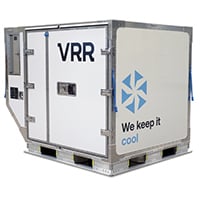
Cool containers
Transporting perishable goods like food and pharmaceuticals? Guarantee your customers an unbroken cold supply chain with our series of temperature-controlled containers. Built to survive the rigours of air transport and harsh environments.

Customised high-end solutions
When you’re transporting valuable cargo that’s complex, over-sized and/or overweight, or you need a customised multi-modal solution that meets the highest standards. Our engineers excel at co-creating unique containers and pallets for specialised transport.
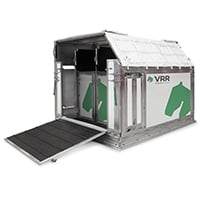
Horse air transport
VRR is a first-class manufacturer of certified ULD containers for the safe, comfortable and efficient transport of livestock. Our state-of-the-art horse stalls offer a maximum level of animal welfare and groom safety.
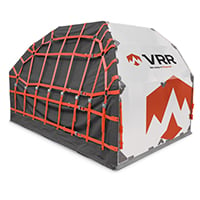
Fireproof & Fire Resistant containers (FRC)
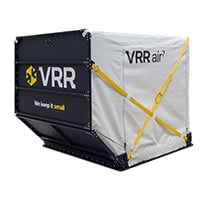
Inflatable & Collapsible containers
Horses on airplanes: 9 ways to upgrade their safety and comfort.

If you’re involved with horses on airplanes , you know that it requires careful planning and exceptional care. Whatever the reason for flying—an international competition, a winter holiday in Florida or a permanent relocation—safety and comfort is always top of everyone’s agenda.
Thankfully, specialised horse air transport services enable thousands of horses to fly around the world every month without any problems. However, not all horses like to fly, and nervous horses can become stressed and risk hurting themselves and their handlers.
At VRR, we take a keen interest in what makes a horse feel safe and comfortable while flying. It’s why, when we design our closed horse stalls, we collaborate with those who really understand horses. One of those collaborators is Lodi Berk, Regional Cargo Sales Manager Live Animals for Qatar Airways.
Berk takes some time out of his busy day to share with us the primary factors to consider when shipping horses by air, and why he prefers certified stalls for the horses under his care.
Prefer to get a quick overview? Just download the infographic, giving you all the info you need.

How to make horses on airplanes more comfortable
1. use expert handlers.
Transporting horses by air is a complex, high-touch process that involves many people, from freight forwarders to airline staff. If these people are not qualified to handle live animals in transit, the horses are unlikely to arrive at their destination feeling rested. They may even come to harm.
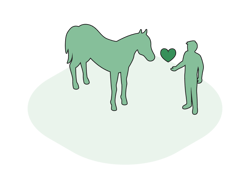
“That’s where a groom’s experience comes into play,” says Berk. “Some horses need a little push; others need a short rest. The spoilt ones like to play. Each one must be handled according to its own needs.” Fortunately, there are several major airlines and freight forwarders that provide specialty cargo services for international horse transport these days. IATA also issues (CEIV) Live Animals certificates to organisations that meet industry standards, making it much easier to check a party’s ability to transport horses by air efficiently and humanely.
2. Establish an organised and timely boarding process
More and more airports, like Amsterdam (Schiphol) and New York (JFK), are providing dedicated facilities where carriers can safely load horses into the ULD or air stall, which is then brought planeside. Efficient documentation checks, specially designed quarantine and loading areas, and 24-hour veterinary services all help to ensure a smooth journey for the horse.
However, even if an airport does not have dedicated facilities, loading horses can still be done in a safe way, according to Berk. “Position the trailer thoughtfully, close to the stall, and lay anti-slip rubber matting in between the two units to prevent the horse from slipping. Creating the right set up prev ents a lot of problems.”
3. Make it easier to load them into the ULD horse stall
Walking into an ULD horse stall can be challenging for some horses, especially if the ramp is narrow and the height is limited.
“It’s not good if a horse needs to bend his head down to walk into a stall, especially if the horse is nervous or claustrophobic,” explains Berk. “A taller stall with a wider ramp and a flat entry—like the HMJ—makes loading much safer and easier for both horse and groom.”

4. Give them plenty of leg (and head) room
Yes, horses can suffer from claustrophobia, too. If the condition is already known about, arrangements can be made ahead of time to give the horse as much space as possible inside the stall. However, as Berk points out, not all owners are aware of the condition until the horse is loaded.
“If a horse is claustrophobic,” he says, “the best solution is to off-load one of the other horses and create more room. Of course, that means the off-loaded horse can’t fly unless you can find space in another stall.”
Moveable stall partitions are a handy feature that make such last-minute flight upgrades possible. Stalls set up for economy class travel (i.e. three horses) can be altered to business class (i.e. two horses) or even first class (i.e. one horse).
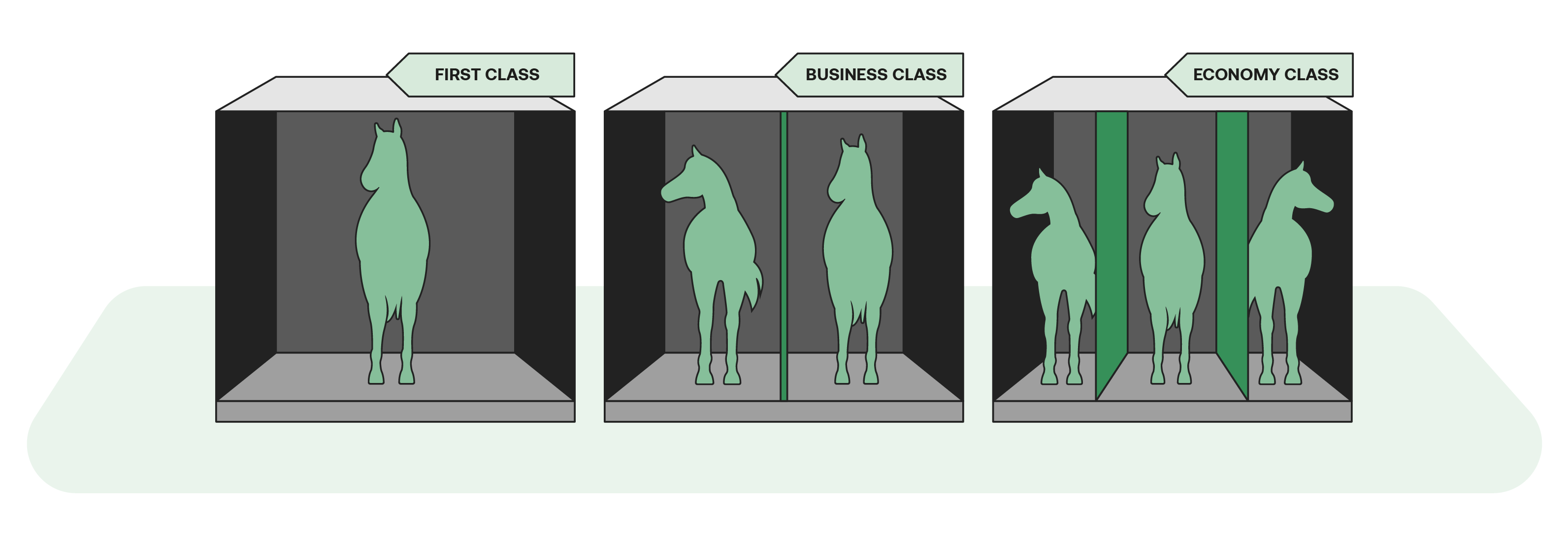
Claustrophobia or no, all horses need room to stretch their necks. This helps them to balance and to cough out unwanted hay and dust. Therefore, sufficient head room is extremely important. “Always make sure the stall fits comfortably around the horse,” counsels Berk.
5. Reduce noise and vibration when being loaded into the plane
Horses can become unsettled while the stall is being positioned in the plane’s hold. They can feel the vibration of the powered cargo rollers as they are being shifted to their location, and inexperienced horses must learn to keep their balance and follow the motion of the container.
However, many horses dislike the moment the high loader lifts the stall into the hold because of the sideways movement. The anatomy of a horse means it is less stable moving sideways. “Claustrophobic horses in particular get distressed at this moment,” observes Berk. “Once the stall starts moving forward or backward, it is much easier for the horses to maintain their balance.”
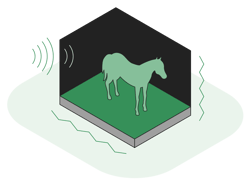
6. Provide a secure and stable environment
The more solid the stall, the more protected the horse, especially if panic sets in. The most solidly constructed stalls are undoubtedly certified containers. Designed to be directly restrained by the aircraft’s Cargo Loading System, they don’t require netting to secure them to the pallet. But, as Berk explains, their advantages extend beyond flight safety.
“Certified stalls are the best way to transport horses. They’re always closed, which makes a horse more comfortable. They are also stronger, so they’re much safer for the horse and the groom . Basically, they are designed to prevent injury and to keep a horse much more comfortable during the flight.”

7. Keep them cool and hydrated
The air in any plane is very dry, and horses can generate a lot of heat, especially on long journeys. However, the risk of overheating and dehydration can be eliminated by providing the horses with enough water and ensuring the stall has adequate air flow.
“Easy groom access to a closed stall is important to monitor, feed and water horses throughout the flight,” says Berk. “A door on both sides of the stall is ideal as usually one side or the other is blocked by another container or loaded pallet.”

8. Enjoy a clean, dry floor for the whole journey
Sooner or later, every passenger gets a ‘call of nature’ on a long-haul flight. A horse weighing 500 kilos can urinate many litres of fluid during that time. Of course, standing on a soiled, wet floor is not ideal, which is why sufficient absorption material such as wood shavings should always be used. It’s also essential that fluids and droppings do not leak from the stall in order to protect the aircraft from dirt and corrosion.

9. Arrange suitable stall neighbours
No-one travelling on a plane wants to be bothered by fellow passengers, and horses are no exception. Unruliness and conflict can occur if neighbouring horses don’t get on with each other, which is why careful thought must be given to their ‘seating arrangements’ prior to flying.
“If possible, don’t put a stallion next to a mare,” says Berk. “Put him next to a gelding or another stallion. If you have a nervous horse, try pairing him up with a calm, experienced flyer. And always try to keep travelling buddies together.”
As an extra precaution, use sniffer boards to prevent horses from nuzzling and biting their neighbours.

Flying horses around the world has become as routine as flying humans. Even so, there are ways to make the flight feel less like economy and more like first class. The key is meticulous preparation and using the right horse stall. If you can meet a horse’s individual transportation needs, you will have a happy and relaxed animal at the end of the flight.
Like to have a reminder or short overview of these valueble tips? Just download the free infograhic.
About Willem Berk
Willem (Lodi) Berk, who has been riding horses since the age of 13, owns several horses. In 2006, he joined the air freight industry as a flying groom. Now he works for Qatar Airways Cargo as Regional Sales Manager Live Animals. He oversees the transportation of all kinds of animals, from horses, cattle and dogs to falcons, elephants and dolphins.
Berk, who is on the board of the Animal Transportation Association (ATA) and the IATA Live Animals and Perishable
Board (LAPB), was closely involved in the design of the HMJ. He believes it is one of the best certified horse stalls on the market.
More information on certified horse stalls?
If you’d like to know more about VRR’s certified ‘ Horse Stalls ’, you’ll find plenty of information on our website, including technical data and brochures that you can download.
Subscribe to the newsletter
Stay up to date on all our product innovations and news. Over 500 people already joined and counting.

Relevant posts
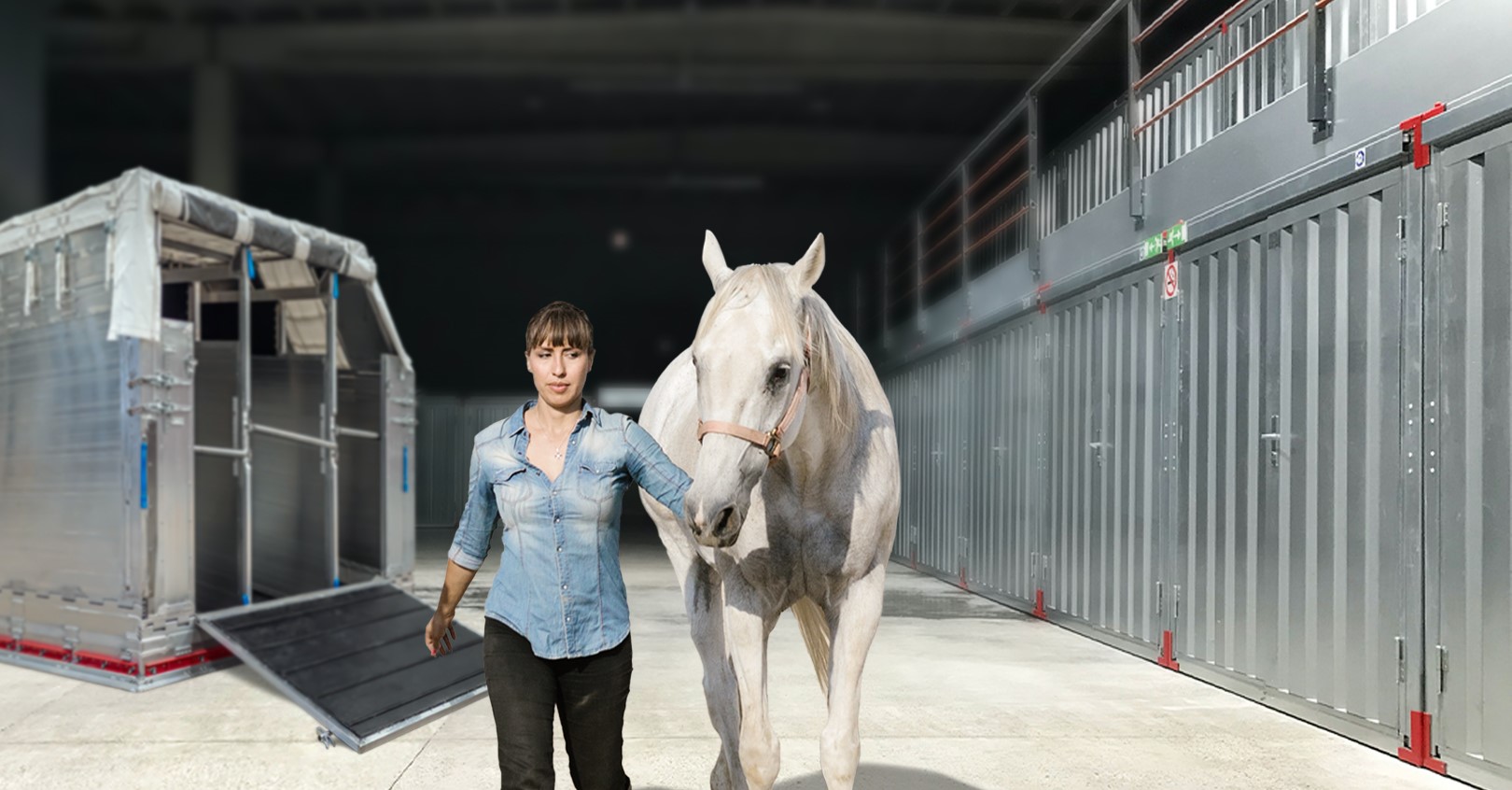
Certified Aircraft Horse Stalls: Why Are They Your Best Choice?
Shipping horses by plane is commonplace these days. Nevertheless, choosing the right air horse stall can be complicated...

If you’re involved with horses on airplanes, you know that it requires careful planning and exceptional care. Whatever...
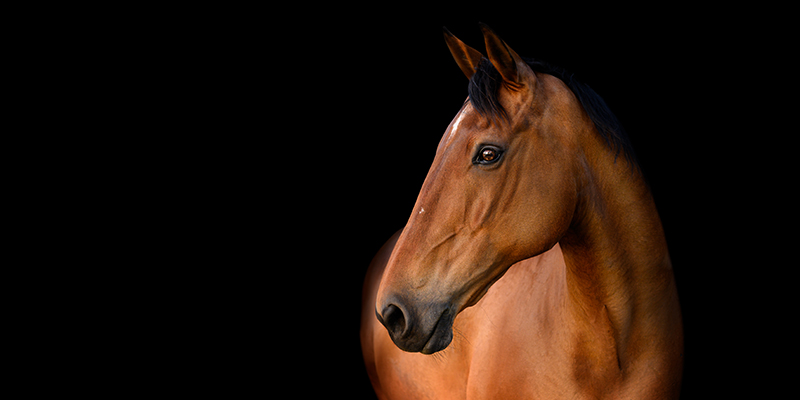
Shipping Horses by Air? How to Choose the Right Stall.
When it comes to travelling on airplanes, horses have pretty much the same needs as humans. Both want comfort and extra...

Tel +31 (0)10 479 8100
Stolwijkstraat 57 3079 DN Rotterdam The Netherlands
Join us on LinkedIn and stay up-to-date on the news
Horse Shipping during COVID-19. Find out more

- Australia P.+61 3 9643 3000
- New Zealand P.+64 9 297 2022
- USA P.+1 630 377 2300
- UK P.+44 1638 668 003
- Europe P.+49 171 784 74 47

Flying horses internationally and domestically servicing all major domestic airports including Alaska and Hawaii
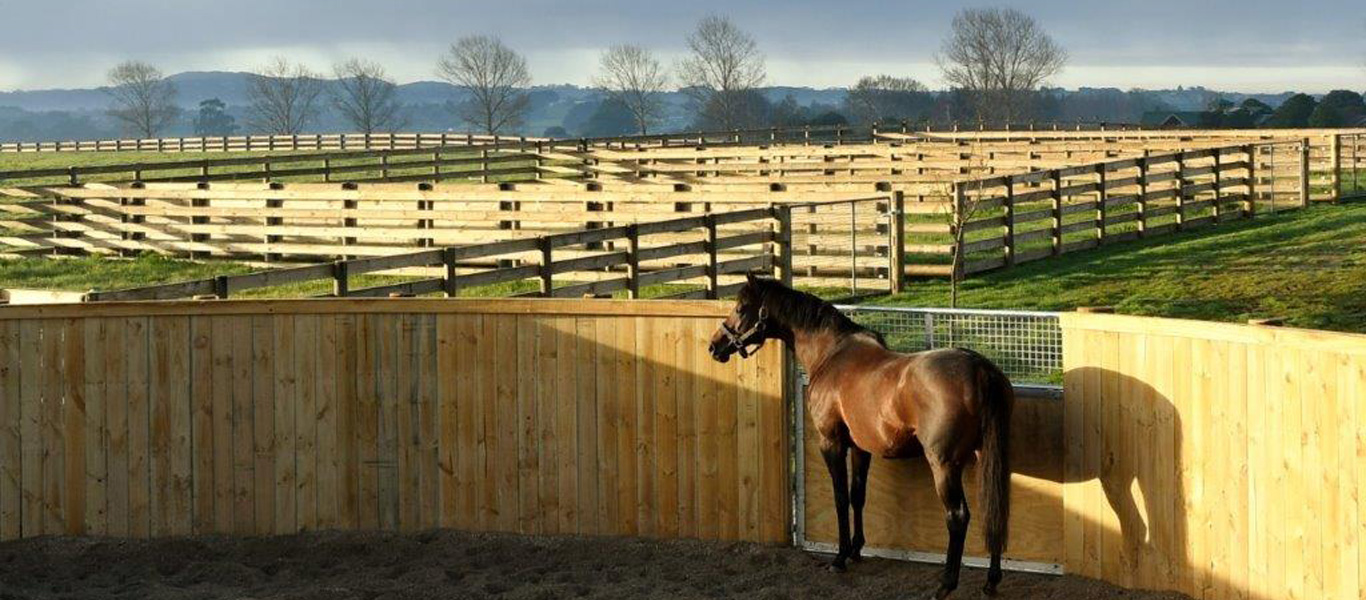
Transporting your horse has been our passion for over 50 years.
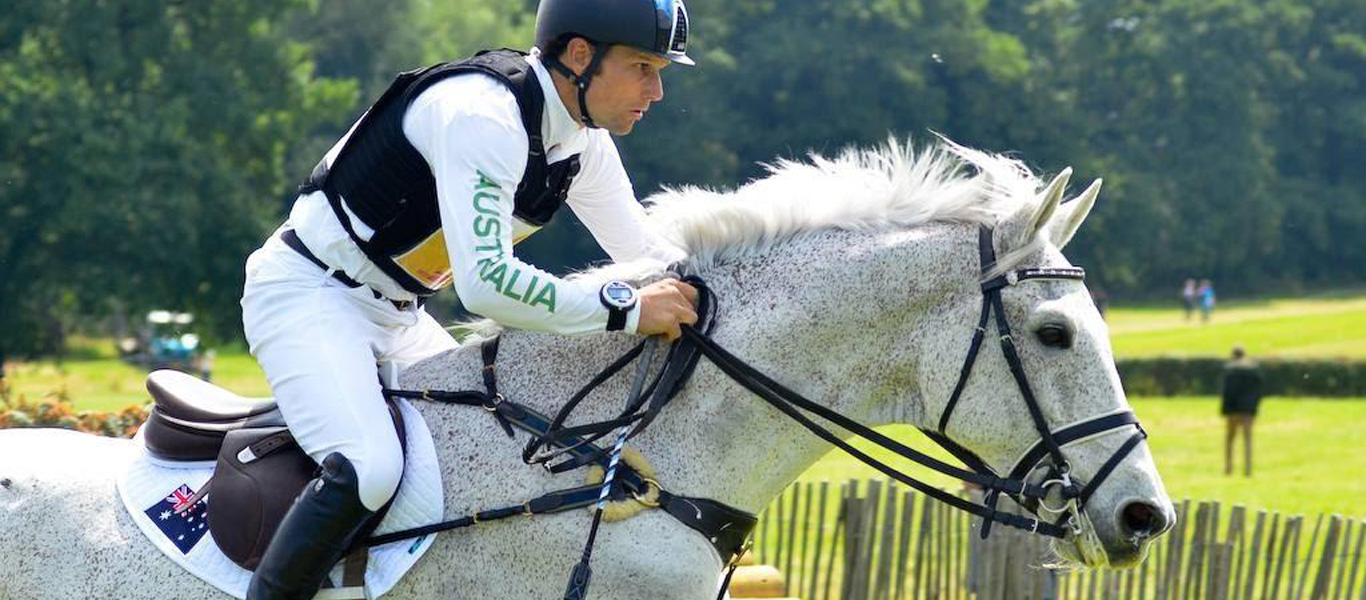
FIND FLIGHT
With offices in Australia, New Zealand, the UK , Germany and USA, IRT's International coverage means that our professional and experienced staff can better facilitate horse shipment all around the world.
- Testimonial
- 50 Years of History
A true frequent flyer, ‘More Than Ready’ has travelled beautifully under the care of IRT on 16 international round trips from the USA to Australia.
Navvy ( Evers Navarone) is here safe and sound! Thank you so much for all your help in getting him here. He is in fantastic condition.
The service you provide is just amazing! I was rather worried about sending my three horses from Europe/UK to the USA as I had never shipped horses before and it was a complex plan. But IRT managed it all so easily! Fantastic! Thank you!
Thank you for another easy, flawless import, you guys do an awesome job!
IRT have been a fantastic partner for many years, successfully shipping our horses across the Trans-Tasman for races in Australian and New Zealand.
Thank you IRT! You're the BEST! -- (IRT partnered with the Square Peg Foundation and California Retirement Management Account to fly three retired Thoroughbreds to their new home, Dillingham Ranch on the North Shore of Oahu, Hawaii.)
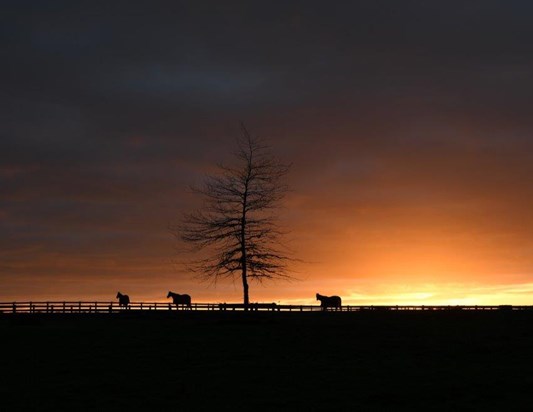
We are the global market leader in horse transport with experience spanning over 45 years. As a business we are extremely proud of our success which is grounded in trust and an unwavering commitment to our clients and their specific needs.
With vast experience in the shipment of all types of equine breeds and a global footprint across five countries, we understand the nuances of global markets; be they diverse customer needs, government requirements or market forces. Each IRT office has an IRT Partner at the helm, all with industry experience spanning 10 to 50 years in the horse shipping arena.
Widely renowned as a world class horse transporter, we take great pride in our customer relationships, our reputation for first class service, the rigour we apply to safety and compliance, and our expert employees.
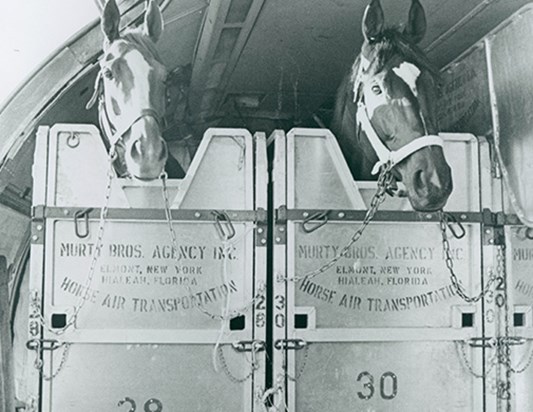
As IRT reflects on over four decades in the industry, company founder Quentin Wallace would like to send a message to its supporters across the world:
"What an amazing journey it’s been. On behalf of the global team at IRT I’d like to say a big thank-you to our many valued customers and friends for your trust and continued support."
- The IRT Journey
- Milestones and Highlights
Latest with IRT
Your horse. our passion.
Whether it's flying a champion racehorse, Standardbred, Olympian or treasured pet, IRT's commitment to serving the international horse community has stood the test of time.
Before the flight
During the flight, after the flight.
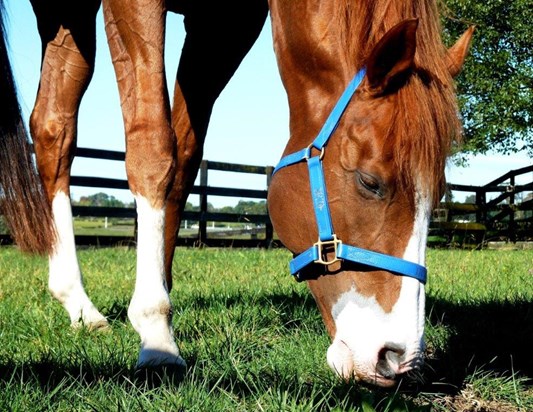
Before your horses travel anywhere around the world, IRT trained staff are at your service to guide you through the many requirements of International Equine Travel.
IRT take care of all pre-flight requirements, step by step, leaving you with complete peace of mind.
IRT provides the following pre-flight services:
- International Airfreight and Charter Services
- Health and Quarantine Services
- Customs, Permits and Insurance
- FAQs Before the flight
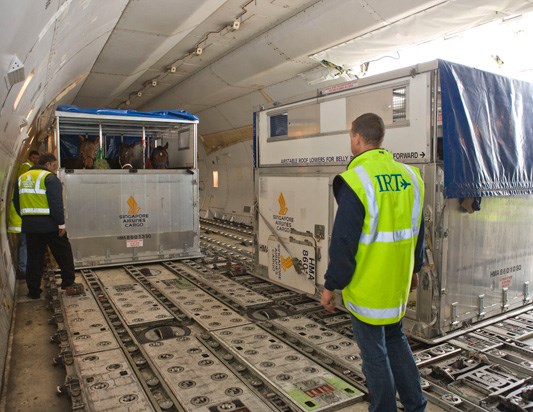
It could be said that what really sets IRT apart as the best in the business is the in-flight experience. Your horse will enjoy unrivalled levels of care and comfort while in the air with particular attention paid to:
- Transit and Stalls
- Professional Horse Grooms
- Experienced Vets
- FAQs During the flight
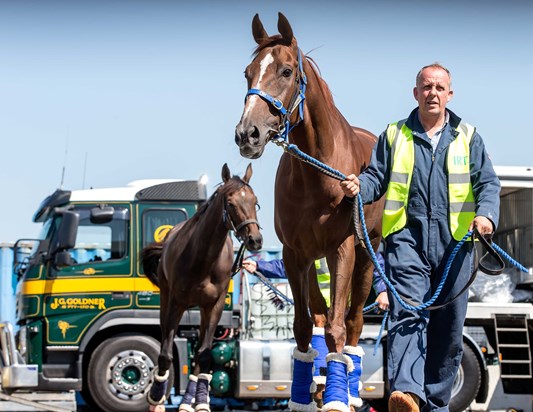
After the flight, all horses continue to be supervised by IRT staff right through to quarantine release.
The post-flight experience is oriented around customs and quarantine protocols and safe delivery of your horse:
- Post Arrival Quarantine and Customs
- Safe Delivery of Your Horse
- FAQs After the flight
All you need to know
No. IRT will complete all necessary tests required on your behalf.
No. IRT take care of all import/export permit requirements at the port of arrival and departure.
IRT can easily organize transport. However, if you particularly wish to deliver your horse, arrangements can sometimes be made for you to do this.
IRT - as part of the planning process for each shipment, an IRT consultant will send you a questionnaire. Once you have completed this and returned it to the appropriate IRT office, all necessary Customs arrangements can be made on your behalf.
Payment will be required 7 days prior to the departure of the shipment.
Pre Export Isolation (PEI) is required on most exports, with length determined by the country which the horse is being exported to/from.
Depending on shipment sizes, available groom seats and airline policies. As a general rule, all IRT shipments are supervised by an animal air attendant (or 'groom') provided by IRT.
No deposit is required, however similar to passenger tickets, payment is required a minimum of 7 days prior to the departure of the shipment.
We advise all clients to contact with their IRT representative regarding upcoming flight dates and possible intake windows for quarantine.
To make a booking please complete the IRT Shippers Letter of Instruction .
Again depending on country requirements, will determine how in-foal a mare may travel. For example horses may travel up to 300 days in foal to NZ however only up to 240 days in foal to South Africa.
IRT advises that all horses are insured therefore talk to your current insurer to discuss adding a transit policy for travel and any geographical limitations your policy may have. If you require insurance IRT can have our Insurance Company call you to discuss options and costs.
Depending on location and distance from port of origin, there will often be fuel or cargo drop/collection stops on the way. IRT Pro Grooms remain with the horses at any stops on the way, and are pre-customs cleared in and out of each country, ensuring your horses are never left unattended.
The horse stalls are loaded on the ground and then raised into the aircraft by lift, maneuvered into place and locked into position.
IRT will supply a new head collar and lead when the horse arrives in our care. When IRT organises pre-flight quarantine a loan rug will be provided for this stage of the shipment.
IRT generally recommend against the use of leg bandages and wraps/boots. If you wish your horse to travel with these, please speak with your IRT consultant.
For the safety of your horse and the people handling it during transit, IRT generally recommend all shoes be removed for the journey. Exceptions can be made for horses with tender feet or brittle hooves.
No. Tranquillizer is generally only administered if deemed absolutely necessary on safety grounds.
All horses travel in an airline approved horse stall.
Yes. We commonly refer to a single space in a stall being economy (3 horses to a horse stall), space & ½ being business (2 horses to a stall) or First Class being 1 horse in a stall on its own.
In most cases, PAQ will be spent in an approved quarantine facility conveniently located to the port of arrival. However, quarantine regulations vary depending upon country of import - refer to your IRT consultant for further information.
In most cases your horse will be met by an IRT representative or their Agent.
Yes. As a general rule IRT will advise you once the horse has arrived at its destination. However, if your local representative is meeting the horse they would normally contact you direct. IRT takes particular care to make sure horse owners are well informed throughout the shipping process and make staff members responsible for your shipment readily available.
All Government quarantines are supervised by representatives from the local veterinary authority. Depending upon the route, the care of your horse will be in the hands of an IRT representative or their Agent or the quarantine manager.
All horses arriving into Australia (except from New Zealand) must do post arrival quarantine at Government’s Post Arrival Quarantine Facility.
No. Horses can only travel on main deck cargo freighters.
IRT - as part of the planning process for each shipment, an IRT consultant will send you a questionnaire. Once you have completed this and returned it to the appropriate IRT office, all necessary Customs arrangements can be made on your behalf both for the departure and arrival customs entries.
In the USA, we use these major airports for domestic horse transportation: Los Angeles, Newark, Indianapolis, Oakland, Seattle, Fort Lauderdale, Miami, Honolulu, Anchorage, Orlando, Memphis, and Baltimore-Washington.
Get in touch
- Quote request
- Leadership team
5 Apac Drive Melbourne Airport, VIC, 3045
P. +61 3 9643 3000
F. +61 3 9643 3030
126 Muir Road Karaka Papakura 2580
P. +64 9 297 2022
F. +64 9 298 6066
- Los Angeles
1525 Kautz Road Suite 1600 West Chicago IL 60185
P. +1 630 377 2300
F. +1 630 513 0412
IRT USA LLC P.O Box 91217 Los Angeles, CA 90009-9997
P. +1 310 306 0262
F. +1 310 306 2003
Clifton House 121 High Street, Newmarket Suffolk CB8 9AE
P. +44 1638 668 003
F. +44 1638 665 534
Martin-Luther-Str. 5 31655 Stadthagen Germany
P. +49 171 784 74 47
F. +49 5721 990 49 93
New Zealand
United kingdom.

Christopher Burke
M. +61 411 707 707
E. cburke(at)irt.com
For over 20 years, Chris has been instrumental in maintaining IRT's edge in an increasingly competitive market. Combining equine expertise with his passion for problem solving has helped him drive progressive business practices and innovation.

Lachlan Ford
M. +61 411 709 709
E. lford(at)irt.com
With over 15 years experience and a genuine passion for the horse industry, Lachlan understands global market requirements, helping him successfully fulfil his clients' needs, specifically in the Asian and South African Markets.

Selwyn Wallace
M. +61 411 704 704
E. swallace(at)irt.com
With over a decade experience in customer service and logistics, Selwyn joined IRT in 2015 managing the Los Angeles Office before returning home to IRT Australia in 2018. The son of IRT Founder, Quentin Wallace, Selwyn's passion for the industry and ability to navigate the complexities of equine logistics has been a lifetime in the making.

M. +64 21 921 677
E. dcole(at)irt.com
As co-founder of IRT NZ with over 38 years in airfreight logistics, equine disease and in bound quarantine requirements, David has contributed enormously to IRT's success and remains a proactive leader in the horse industry.

Richard Cole
E. rcole(at)irt.com
Richard combines his passion for the horse industry with many years' experience in global licensing to ensure high levels of customer satisfaction. Richard's operational background offers a keen understanding of meeting client needs.

E. mhaug(at)irt.com
Matt has been with IRT for nearly 20 years. Having forged his career from the ground up with IRT, Matt is a terrific example of what a relentless drive for success can achieve.

Martin Coakes
M. +44 7887 530 313
E. mcoakes(at)irt.com
Martin brings to the IRT leadership team a strong equine industry pedigree, with experience spanning 20+ years in both shipping and high-profile stud farms. Having held senior roles in Australia, USA and the UK, Martin has a deep knowledge of shipping and understands the protocol nuances across different markets.

Claudia Friedrichs
M. +49 171 784 7447
E. cfriedrichs(at)irt.com
A proud German, with over 16 years’ experience in the equine industry across Germany, Europe and the USA, Claudia brings to the IRT team a deep understanding of logistics, coupled with an innate understanding of her clients’ needs. A passionate horse owner herself, Claudia has a genuine love of the industry.

Quentin Wallace
As our founder, Quentin has successfully guided IRT for 45 years, expanding and maintaining our market leader position. After 50 years shipping horses, Quentin still places great emphasis on customer service and attention to detail.

Tamir Bowen
E. tbowen(at)irt.com
Tamir has over 15 years' experience in managing IT and software development and has a passion for keeping IRT at the forefront of new technologies, notably implementing our state of the art, customised CRM system.
IRT's ability to provide high quality services is directly dependent on our staff.
With more than 40 office based staff worldwide, and our team of dedicated and professional attendants, IRT's ability to provide excellent service is dependent on excellent staff. We have a wide range of opportunities for the very best people in the industry who have a genuine passion and the right level of experience.
If you would like to be part of our team, feel free to email a covering letter and your resume to our Human Resources team at employment(at)irt.com.
Our Partners

- Site Usage Terms
- Privacy Policy
- Trading Conditions
- Shippers Letter of Instruction (SLI)

Horseflight.
Excellence in International & Domestic Horse Shipping
Horseflight

We Love Horses and Horses Love Us
We’ve been flying horses worldwide for over 20 years.
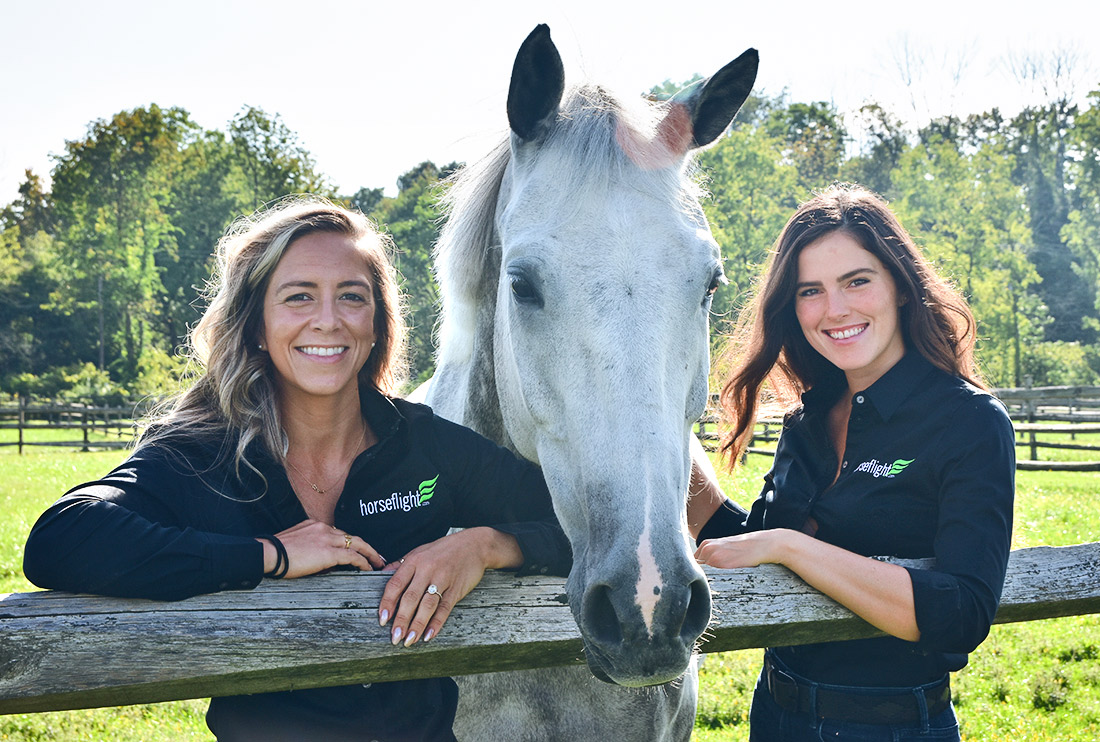
Why Horseflight?
Learn why we’re the best choice for your international and domestic horse shipping needs.

Meet the Team
Get to know our experienced, passionate, and extremely capable Horseflight® team.
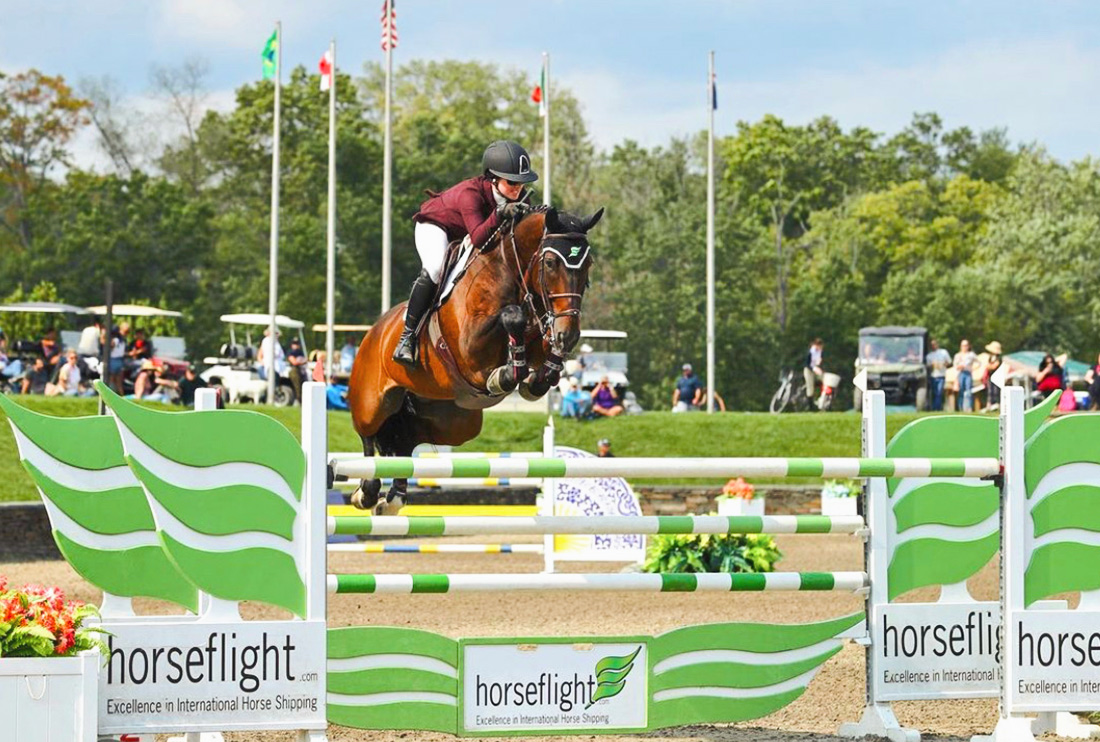
Request a Quote
Our pricing is fair and our service is next-level. Begin the process and see for yourself.
Specific Delivery Date Needed? No Problem.
Standard scheduled flights in and out of the following:
NOTE: we provide domestic service to the majority of U.S. airports. For international flights we fly into all USDA approved ports.
JFK (New York) MIA (Florida) ORD (Illinois) LAX (California)
AMS (Netherlands) LGG (Belgium) FRA (Germany) LUX (Luxembourg)
Middle East
JDXB (Dubai) KWI (Kuwait) RUH (Riyadh) DMM (Dammam)
Our trusted airlines in equine transportation include Lufthansa, Cargolux, CAL, Martin Air, Qatar Airways, Cargojet, Air France, FedEx, and DHL.
Door to Door Has Never Been Easier
All flights are built around your schedule. Due to Horseflight’s extensive network, we can arrange all ground transport in conjunction with your flight.
Safe. Secure. Comfortable.
A truly professional organization. HorseFlight has always provided the best service in the industry! It is a comfort to know my horses and those of clients are in the best hands.
★★★★★ Andre Dignelli Heritage Farm, Katonah, NY
“A truly professional organization. HorseFlight has always provided the best service in the industry! It is a comfort to know my horses and those of clients are in the best hands.”
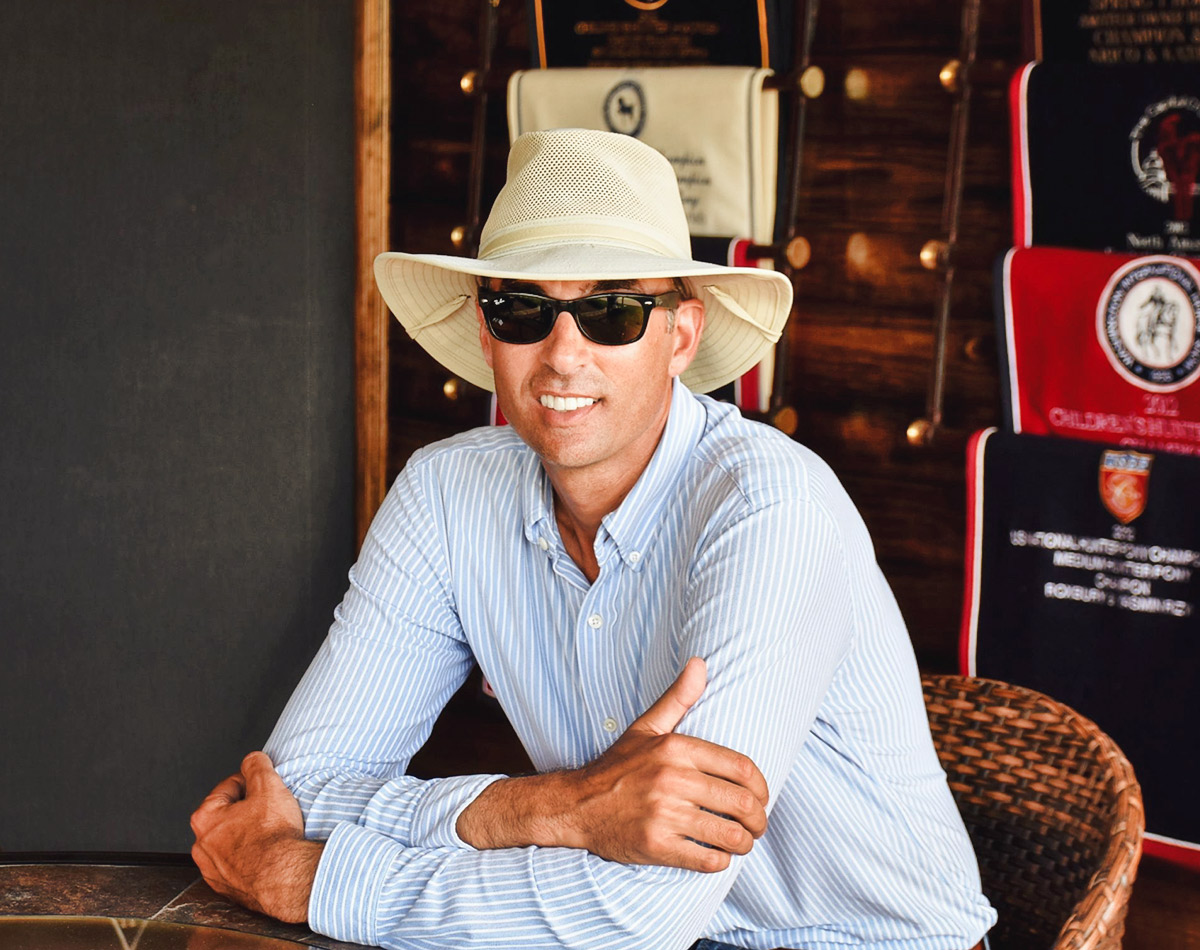
Simple for You, Safe for Your Horse.
Why Choose Horseflight?

Impeccable Safety Record
Over the past 20 years, we’ve shipped thousands of horses in top competing condition. Your horse’s safety is our top priority.

Trained Health Professionals
Proper nutrition, early detection of elevated vitals, and a controlled, safe environment are all guaranteed throughout your horse’s journey.

Expert Communicators
During transport, you’ll be updated every step of the way with photos and text messages. We won’t leave any room for guessing.

Transparent & Honest Pricing
Integrity is everything to us. You won’t have to worry about hidden fees or unexpected costs. The price we give you is the price you’ll pay.

New Jersey Office
237 Old Turnpike Road Califon, NJ 07830
Email [email protected]
Phone +1 844-832-5848
Florida Office
11924 Forest Hill Blvd Suite 10A-216 Wellington, FL 33414
- Paris Olympics
- Subscribe & Save
- In H&H magazine
- The H&H Podcast
- Horses for sale
- Sell your horse
9 things you might not know about transporting horses by aeroplane
- Top stories
- Transporting horses
Flying horses around the world requires impressive levels of organisation. Horse & Hound watches the operation swing into action at Heathrow, with horse transport company IRT ahead of a flight to Australia
A busy schedule
Around 5,000 horses fly globally each year with horse transport company IRT — every hour of every day, they have a horse in the air.
There has to be 14 days of quarantine either side of flying horses to Australia, but IRT does three weeks to allow for the testing. “The level of isolation is extremely detailed — the showering protocol includes washing your hair and brushing your nails,” says IRT’s European managing director Jim Paltridge.
The stalls take up to three horses (it costs roughly £14,350 per horse to fly to Australia, including quarantine, vet and transfers fees), but clients can pay 35% more for “business class” (two horses per stall) or “first class” (single horse, 70% more), for instance for stallions or racehorses running in the Melbourne Cup.
Each horse has two haynets — small-gauge to keep them grazing throughout — and will lose five to 15kg during the flight, but they’ll put this back on within five days.
“The IRT subcontracts a vet for the flight. This isn’t law, but once you go over 12 hours’ flying, it’s dangerous territory for shipping fever,” explains Jim. “Having a vet on board is the best way to care for them. Top-class travelling grooms are so important; they can recognise when a horse is off-colour like a mother with her child. But the vet is there for things like administering fluids if the horses aren’t drinking after eight hours.”
Transferring the horses from lorry to stall is a slick procedure. There is a “load plan”, denoting where every horse will “sit”. The horses have been “buddied up” during quarantine, so they are used to their fellow passengers.
The lorries park alongside the stall, and the handlers pull down the ramp directly into the stall. The horses are led in chifneys and most walk straight in.
The stalls are then transferred to a scissor-lift high-loader, cranked up into the air and deposited through a huge opening into the plane.
As each stall comes into the aeroplane, the grooms open the flaps at either end to allow the air in, and check the name stickers on the quarters. It heats up quickly in the aircraft and the air is soon thick with the familiar horsey smells of manure and haylage.
The gloom inside seems to steady the horses — there’s no neighing or clattering, and the grooms’ calmness seems to rub off.
“The ideal scenario is not to disturb the horses too much, just for the four-hourly drink checks,” says Jim. “It’s like a matron on a ward at night. You want a relaxed environment and to leave the horses alone.”
Travelling gear
As I’m shivering, I notice that all the horses are clipped out and travel without rugs — however, with the stalls flaps buttoned down, they are toasty warm. They are clipped in the UK, because, if they emerge into the 40°C heat of Singapore and Melbourne with thick, sweaty coats, clipping is impossible, and overheating is enormously stressful. The horses travel with no hind shoes, unless they have brittle hooves.
Dealing with problems
Besides loading, the staff also keep tabs on any trouble in the stalls. Early on, a warmblood gelding starts banging, and vet Katie Wilcox is quickly on hand to give it a dose of sedative.
“It lasts for two to three hours, but they usually only need one dose,” says Jim. “We don’t use much sedative [three during this loading procedure], but it puts them in dreamland, so they can relax and not upset the others.”
Jim, who is also busy intervening at the first sound of a kick, says horses falling over or rearing is rare: “A good groom makes up for a lot of sedative. We have very good horsemen, who can calm the horses down. Some even sleep under the horses’ heads.”
Terrified of towing? Follow this advice to get you from A to B safely
First horses arrive at world’s only private airport lounge for animals, subscribe to horse & hound magazine today – and enjoy unlimited website access ready for the olympics and more, shipping fever.
The main concern is shipping fever — statistically, one in six will suffer from this form of pneumonia on a long-haul flight. The infection, which starts in the windpipe and spreads to the lungs due to the horse not being able to do postural drainage with his head up, is exacerbated by the bacteria in the faeces in a confined space, the warmth of the stall and limited airflow.
“It’s rare for a horse to die of it now, and quite rare for it to develop into serious illness, unless it is not detected and treated with antibiotics and fluids,” explains Jim. “We give all the horses three doses of electrolytes during the 24-hour trip, which incentivises them to drink. If they keep drinking, they should stay healthy. The grooms encourage the horses to put their heads down, by feeding them on the floor.
“We have intravenous fluids on board, and we do blood pictures on any horse that’s not bright and straight into its food and drink when it arrives, which warn us if the fever has taken hold before the temperature rises.”

You may like...
The rider who lost his olympic place, a pony found in a shipping container, and other things the horse world is talking about, couple’s ‘good day all round’ with hole in one, personal best – and a show centre proposal, first win for equestrian olympic team, with ‘ros canter’ – and a shetland pony.

Is that a horse on my flight? New rules clarify which animals can fly with passengers

Abrea Hensley goes everywhere with her miniature horse. To the grocery store. To restaurants. To the movies.
Hensley’s horse is a lifesaver. With a variety of psychiatric disorders, Hensely depends on Flirty to alert her to anxiety attacks, steady her mobility and remind her about taking her meds.
Flirty stands about 27 inches at the shoulder, and came into Hensley’s life two years ago.
“She’s given me back my independence. Before I got her, I couldn’t even do simple tasks,” she said. “I was almost homebound before I got her.”
Now they could even fly commercial together —although Hensley hasn’t attempted to do that yet.
Although service animals have been allowed on flights, the U.S. government recently clarified the rules to specify that service horses can fly with their humans in need.
While Hensley said she isn’t ready to bring Flirty on a plane and possibly deal with reactions from fliers, she wants people to realize that service miniature horses are no different than support dogs.
“People don’t realize the level of training these animals have,” Hensley said. “They won’t poop on the plane. They are potty trained.”
For years, guidelines on which service and comfort animals could board a flight were called confusing and vague. Passengers, and even the crew, questioned the verification process for furry seatmates.
Growing public pressure from airlines and passengers led the U.S. Department of Transportation to create the new, clarified guidelines.
Here is what the DOT says:
“We believe that it would be in the public interest and within our discretionary authority to prioritize ensuring that the most commonly recognized service animals (i.e., dogs, cats, and miniature horses ) are accepted for transport.”
Before you worry about snakes on a plane, airlines can still say no to reptiles, along with ferrets, rodents and spiders.
But airlines cannot ban a specific species or breed of service animals, like Delta tried to do with pit bulls . “Enforcement action,” however, will only be on a case-by-case basis, according to the final statement document.
Airlines will still have the call on refusing to let an animal aboard. They can say no if the animal:
▪ is believed to be a threat to health or safety.
▪ is too large or too heavy for the cabin.
▪ is disruptive and is not in complete control of the owner.
▪ isn’t housebroken.
▪ isn’t allowed in the country the plane is traveling to.
Airlines can request owners with emotional support animals give 48 hours’ notice and fill out paperwork, including a mental health professional form attesting to the need for the animal.
The agency gave airlines up to 30 days to update their policies to reflect the new regulations. Some of the suggestions and restrictions were already in individual airline policies.
Jessica Wellman, a service miniature horse handler and service animal trainer, hopes the clarifications will “make it easier for people who legitimately have and require the use of service animals instead of the people who go on and say this animal is a service or ESA [emotional support animal] to get them on a free flight.”
But frequent fliers like Abe Laeser, a former Miami-Dade prosecutor who has severe dog allergies, aren’t sure the clarifications will solve anything.
“It seems silly to bring a horse on [a plane]. What’s next? A baby rhinoceros? A pet alligator?” said Laeser, who lives in Weston. “Someone is going to have an iguana they caught in their backyard and they’re going to want it in there.”
Forget about iguanas — miniature horses are great service animals for mobility work, Wellman said. One of the perks is that they live long, up to 35 years, and can work for about 20 years.
COMFORT ANIMALS ‘ARE THE PROBLEM’
While Laeser finds the thought of a horse — even a mini one — on a plane odd, he said he doesn’t have a problem with trained service animals in general. He just doesn’t want untrained “comfort animals” flying in the cabin with him.
“I find there is a pet on almost every flight that I take,” Laeser said.
Unlike a service animal that is trained to do specific tasks like leading blind and visually impaired people around obstacles or detecting seizures before they strike, any animal can qualify to be a comfort animal with typically little or no training. These animals provide emotional support and comfort to their owners through companionship.
Laeser doesn’t agree with the 1986 Air Carrier Access, which requires airlines to carry not just trained animals but any animal that “assist the customer with physical/emotional/psychiatric/medical support.”
People, Laeser said, are using the vagueness of the term “comfort animal” to cheat the system and get their pet to travel for free without a cage.
“They are making a decision to have Fido on their lap and somehow that’s more important than me being able to breathe for two or three days,” he said.
Maria Olga Toledo, who lives in Miami, agrees and said she’s had several “nightmare” experiences on a plane. In one of them, a cat with a long leash began running up and down the aisles when she was sleeping, and almost gave her a “heart attack” when it went through her legs.
HER INCIDENT WAS TAME COMPARED TO OTHERS
In December 2017, an emotional support pit bull bit a 5-year-old girl on the face at an airport in Portland, Oregon. In June 2017, another emotional support dog flying with an ex-marine reportedly attacked the man sitting next to the marine.
“Flight attendants have been bitten by some of these emotional support animals,” Taylor Garland, spokeswoman for the Association of Flight Attendants union, told the Miami Herald in February 2018. “Emotional support dogs that were clearly not trained to be on a plane have bitten real service dogs who are. There’s a security issue — any kind of chaos in the cabin, the crew has got to worry that it’s a diversionary tactic for something much worse.”
And don’t forget the poop and pee.
“Defecation and urination are a big issue,” Garland said. “A big issue.”
Laeser also doesn’t believe the airlines are properly vetting the furry passengers.
“No one from the airlines is at the gate asking if you have the right papers,” Laeser said. “I don’t care what the airlines say no one is getting thrown off because they didn’t bring their papers with them.”
It’s also easy to buy an official-looking emotional support certificate or ID card bearing your pet’s holographic image online, though some airlines like American Airlines have reinforced their policy to require a letter from a mental health professional reaffirming the passenger’s need for the animal.
Those who are caught misrepresenting a service animal , however, could be fined $500 in Florida and may face up to 60 days in jail.
While Hensley and Wellman don’t think fake service and comfort animals are as common as some make it seem, they both say it causes trouble for those with real service animals. They themselves have experienced it.
Hensley, who lives in Nebraska, said Flirty is about two inches taller than a golden retriever. A Great Dane, which is a popular service dog breed, “would tower over her,” according to Hensley. It doesn’t stop the “harassment.”
People have tried to climb onto Flirty, who weighs 136 pounds, and have even told Hensley she shouldn’t be bringing livestock inside. They don’t realize she’s a legitimate service horse, she said.
Wellman, who lives in Ocala and is a service animal trainer, has also had problems at home.
One of her neighbors didn’t like having Honey, a 31-inch tall miniature service horse, and a service horse in training next door. The problem quickly escalated.
“We had to go to court to keep her on our property,” Wellman said.
Wellman has a progressive autoimmune disease that gives her joint and inflammation issues. She also has Crohn’s disease. She already had a service dog but luck brought Honey to her.
“I actually won her in a $5 raffle,” she said. “I never intended to really get her. I pretty much put money in to a raffle. ... Then they called me and were like, ‘You won!’ And I was like, ‘Oh, goodie, what did I win?’
“She was the grand prize.”
Since that day in 2010, her “cane with a brain” has been helping her move around. She also provides some emotional support.
“She’s freedom, she’s security, she’s really just always able to help me out no matter what,” Wellman said. “That freedom of not having to rely on another human being to do just kind of normal simple things that most people take for granted.”
Wellman and Hensley said people need to realize that the animals they’re seeing in restaurants or flights with behavior problems aren’t legitimate service animals. Honey and Flirty, for instance, received training for two years.
People, Wellman said, rarely notice or hear stories of service animals doing their jobs — like earlier this month when a woman traveling to West Palm Beach passed out and was saved by her service dog .
Since 2011, the American Disability Act has allowed miniature horses that are “individually trained to work and perform tasks for a person with a disability” to be considered service animals. Previously, only dogs were officially recognized.
That doesn’t mean you won’t have a service pig or monkey as your seatmate . They could be considered service animals , but it’s up to individual carriers to decide on a case-by-case basis, according to the Americans with Disabilities Act National Network.
But, what about a peacock?
While airlines are not required to accept “unusual service animals,” the policy does not completely define the term. Airlines requested that the DOT declare a wide variety of species — including birds, hedgehogs and animals with hooves and horns — “unusual service animals” and allow them to be categorically banned. The agency refused, saying it didn’t have the authority.
Now that the DOT has clarified that miniature horses can take to the skies, what’s it like to fly with one?
Here’s how it works for Southwest Airlines, which made headlines last year after its updated policy said trained service dogs, cats and miniature horses were welcome on flights.
After checking in at the ticket counter, the passenger and the miniature service horse would board at the gate area, according to a Southwest Airlines spokeswoman. The horse would then be accommodated on the floor of the first row of seats at the forward bulkhead wall, which typically has more room, she said.
Here's a miniature horse on a plane pic.twitter.com/1aSt94nvDW — Dr. James Kelleher (@etienneshrdlu) October 22, 2016
Even with the extra space, Wellman said she would probably buy the seats in the entire row if she decided to fly to make sure she wouldn’t bother anyone.
But, Wellman and Hensley hope the consideration goes both ways.
“Ignore the service animal,” Hensley said. “Pretend it’s not there and interact with the person like they’re a normal human being.”
SPECIAL NOTE TO CLIENTS REGARDING COVID-19
Dear valued clients,
During this challenging time that we are all enduring, it is with sincerity we express to all of our customers that we here at Tex Sutton are committed to making wise decisions as pertains to our operations. The health and safety of all persons involved is our number one priority.
Currently, there are no Federal or State flight restrictions affecting us. As such, flights will continue to operate as planned, barring any changes to the current situation.
We continue to sanitize equipment, practice personal cleansing (hand washing etc.) and are avoiding close personal contact as recommended.
With the many uncertainties, we are unable to publish a long-term flight schedule but we stand prepared to meet your horse transportation needs once competitions resume.
Be safe, stay well.
Rob Clark President
Tex Sutton Equine Air Transportation
- Flight Schedule
First Class Equine Air Travel
Provider of first class equine air transportation since 1969.
For five decades, the name Tex Sutton has been synonymous with first-class equine air transportation. One of the first horse transportation companies to provide this service; we are especially proud of our reputation as North America’s leader in the field of safe, efficient and timely travel of both race and show horses to all major venues. Interested in more information about our horse flights? Learn more here .

Horse Travel Made Easy: 20 Essential Travel Tips
Traveling with your horse is a lot of fun, but it can seem like a daunting task if you’ve never done it before. If you’re ready to travel with your horse but you’re not quite sure where to start, here are 20 tips for how to travel with your horse.
- Choose the Right Travel Trailer
- Inspect Your Travel Trailer and Vehicle
- Ensure Your Horse Can Safely Enter and Exit a Trailer
- Do a Test Drive Before Extended Travel
- Make a Travel Checklist
- Prepare Your Travel Documents
- Prepare a Travel Timetable
- Check the Weather
- Plan for Recovery Time When Making Plans
- Find Places to Stay
- Take Regular Breaks
- Avoid Grain Before Travel
- Use Trailer Bedding
- Check Your Horse’s Weight and Vital Signs
- Carry First-Aid Supplies
- Consider Using Shipping Boots
- Pack Your Horse Last
- Use Caution When Unloading Your Horse
- Bring Plenty of Hay
- Bring Plenty of Water
- Take Steps to Avoid Shipping Fever
Now that you know all the tips, let’s dive into each one a bit deeper.

Essential Horse Travel Tips
Tip 1: choose the right horse travel trailer.

Horse trailers come in all shapes and sizes, but if you want to ensure your horse will be comfortable for their journey, you’ll need to do some research before purchasing or renting one.
Types of Horse Trailers
Slant-Load Trailers
The majority of horse owners prefer slant-load trailers because they are able to hold more horses in a shorter length trailer. Additionally, the rear entrances of these trailers are very spacious, making the trailer appear more inviting for an anxious horse that might be tentative to board otherwise.
Customizable dividers within the trailer make it easy to use the trailer for your specific needs. There is plenty of storage space at the rear corners as well as the front part of the trailer, and there is enough space for horses to be turned around within the trailer so that they can be led out head first.
Straight-Load Trailers
Straight-Load trailers are the next most popular option. People like straight-load trailers because they usually offer plenty of headspace to carry taller horses, have enough space for horses to lower their heads and brace themselves with their legs, and a walkout door that allows you to remove one horse at a time if needed.
It can be difficult to load a nervous horse onto these trailers due to their narrow appearance. Another aspect to be aware of in these trailers is that the horse will have to back off; there is no way to turn the horse around in these trailers. That being said, you want to make sure you have a horse that will willingly back off a trailer if you plan to purchase a straight-load.
Straight Load trailers appeal to the horse owner who doesn’t want to lug a big massive trailer around. Straight-load trailers are usually only made for two horses, so they’re lighter and smaller.
Stock Trailers

Next, we have stock trailers or livestock trailers. Stock trailers are a popular choice because they are typically cheaper than horse trailers, but still, come the option of customizing their interior for your specific needs when purchasing them new.
Stock trailers are the most inviting for a nervous horse or a horse that isn’t good with loading. These trailers a wide and spacious with no dividers, allowing you to fit more horses in them than any other type of trailer.
When selecting your trailer, make sure that it is strong enough to carry the weight of your horse as well as all of the gear that you plan to take with you. You should also make sure that there is plenty of headspace for your horse, that they have room to lower their heads, and that the trailer is well ventilated.
Tip 2: Inspect Your Horse Travel Trailer and Vehicle
Before you take to the roads, it’s important that you make sure that both your trailer and your vehicle are in good condition.
Travel Trailer Inspection
Inspect the interior of your horse trailer to make sure that there aren’t any sharp or jagged edges that the horse can harm themselves on. A trailer with a lot of rusty edges is just asking for trouble.

You should also sweep and wipe out the interior of the trailer to remove any dust. Once you start traveling, that dust could cause respiratory issues for your horse if not removed beforehand.
You will also want to check your boarding ramps if your trailer has them, to ensure that they are sturdy and not easy to slip on. Check your tires to make sure they’re in good working order and have enough air. Lastly, check the trailer hitch to make sure everything looks safe.
Vehicle Inspection
For your vehicle, we recommend taking it to a shop for a thorough inspection before any kind of extended travel. The last thing you want when you’re towing your horse it to have car trouble, so the extra expense of going to a shop can be well worth it.
Additionally, make sure that the vehicle you’ll be using to tow your horse trailer is properly rated to pull the amount of weight that you’ll have.
Tip 3: Ensure Your Horse Can Enter and Exit a Trailer Before Traveling

For a horse that is used to the wide open spaces of a pasture, entering a small and dark horse trailer can be very intimidating. In the weeks and months leading up to your trip, you should begin doing exercises with your horse to help prepare them to enter a trailer.
Begin by getting them used to being around the trailer and rewarding them for any sign of curiosity that they demonstrate. Once they’re comfortable, allow them to stand with just their two front legs in the trailer. After they do this for a minute or so, have them back out. Eventually, they should enter the trailer and back out of the trailer willingly. If you’d like to learn more about training your horse to board a trailer, here’s a great video we found that will help .
Tip 4: Do a Test Drive With Your Horse Before Extended Travel
Before driving somewhere with your horse for hours on end, it’s a good idea to take at least one test drive with them beforehand. Even if it’s just a 15 or 30-minute drive, doing a test drive will help you practice loading them up and you’ll be able to see how they react to the experience and make other preparations if necessary.
The test drive will also get you comfortable being behind the wheel of a vehicle pulling a horse trailer. It’s important that the driver avoids any sudden stops are lurching starts. These movements can easily through your horse off balance and the could possibly hurt themselves.
Be sure to reward your horse after unloading so that they learn that riding in the trailer is a good thing, and not something that should be avoided.
Tip 5: Make a Horse Travel Checklist

Whether you’re traveling to a competition or to a scenic trail ride location, make sure that you have a good travel checklist with everything that you will need for your journey. Look over this list in the days leading up to your trip to make sure that you have everything that you’ll need.
A good rule of thumb is to bring extras of all essential items like food, water, and riding tack. Even if you think you’ll be fine, having extras of the essentials prepares you for unexpected situations.
A sample checklist might include:
- Horse First Aid Kit
- Health/Registration Papers
- Grooming Equipment
- Spare Halter and Lead Rope
- Multiple Buckets
- Multiple Bridles
- Spare Reins
- Spare Stirrup Leathers
- Extra Water and Hay
- Sawdust Shavings
Tip 6: Prepare Your Horse Travel Documents

A few months before your trip, you should begin gathering all of the documents that you will need. What travel documents do you need to travel with a horse with the US? You’ll need the following.
- Certificate of Veterinary Inspection (CVI)
- Coggins Testing Paperwork
Keep in mind that the exact requirements for paperwork can vary from state to state, so we recommend looking into the rules for the state that you’ll be traveling through. You can find more information on the official USDA website .
When getting the CVI, a veterinarian will thoroughly inspect your horse and will be able to tell you if they are in healthy condition to travel or not. You should also ask the vet if there are any vaccines they recommend getting for the particular area that you will be traveling to.
Tip 7: Prepare a Horse Travel Timetable
Before you head out on the road with your horse, it’s a good idea to have a travel timetable in the hands of your close friends or loved ones. This can be as simple as picking out a few checkpoints on your journey, letting your friends or family know when you should be there, and telling them you’ll call once you reach your destination. This way, if anything goes awry, you’ll have people that can help.
If you’re traveling all day and you’re concerned that your phone might run out of battery before you’re supposed to check in, we recommend getting a small portable charger that can give you some additional battery life. If you don’t have a cell phone, you can also give the address and phone number of the place you will be staying and plan to call once you reach there.
One last good safety precaution would be to create an emergency contact card to keep in the glove box of your vehicle.
Tip 8: Check the Weather Before Traveling With Your Horse

As you’re putting together your travel plans, something important that you should consider is the weather. If you’re traveling in the summer, keep in mind that the interior of a trailer becomes very hot when left in the sun for any length of time. Whenever possible, park your trailer in the shade, and make certain that your trailer has good ventilation. Bring lots of water and offer it to your horse any time you can.
You should purchase a small thermometer to keep in the trailer to check each time you stop. If outside temperatures will be 90 degrees or above, leave as early as possible in the morning so you can beat the heat. Find alternate route options that you can take should you run into traffic. Without the wind from moving, your horse trailer will heat up much faster in stop and go traffic.
If you’re traveling in the winter, make certain that your horse stays well fed and hydrated so they can easily maintain their body temperature. If your horse has been clipped and you’ll be driving through extremely cold temperatures, you should consider bringing a horse blanket along to use. To learn more about taking care of your horse in the cold, you can check out an article we wrote here .
One of the tricky aspects of traveling with a horse is that you can encounter a wide range of weather throughout your travels, so it’s best to stay prepared for any weather conditions you might come across.
Tip 9: Plan for Travel Recovery Time for Your Horse

If you’re traveling to a competition, keep in mind that many horses can become ill for several days after traveling. To ensure your horse will be in healthy condition for competing, it’s recommended that you arrive several days early for your horse to recover. If your horse demonstrates any unusual behavior after travel, you should contact a veterinarian right away to come and inspect their condition.
Make sure you have the contact information of a veterinarian near or in the area you’ll be traveling to. That way if your horse does turn up sick, you can avoid a lot of stress trying to find a vet at that moment.
Tip 10: Find Places to Stay Before Traveling With Your Horse

When searching for a place to stay while traveling with a horse, it can sometimes be difficult to find suitable accommodation. Because of this, you should never start traveling without knowing exactly where you’ll be staying that night.
There are several online resources like this one that can help you locate good places to board your horse overnight. If you’re not able to find something online, your next best option is asking your equestrian friends for referrals of places to stay. If this fails, you can always try calling stables in the area you’re traveling through and try to set up an arrangement with them to board your horse overnight.
If you find somewhere online to stay, do your best to find reviews from other people that have stayed there. When you arrive at where you plan to stay, always inspect the stall where your horse is to be held and make sure it’s in a safe condition BEFORE you unload your horse or sign any papers.
Be sure to bring along hay for your horses to have at the accommodations because many places do not provide this for overnight boarders. There are many facilities that have campgrounds for the horse owners and corrals for the horses, so if you’d rather be close to your horse, these are great places to stay.
Tip 11: Take Regular Breaks When Traveling With Your Horse

While you might be fine only taking a few pit stops, your horse, on the other hand, needs to stop every 3 to 4 hours. Traveling long distances can be hard on your horse’s legs because they are constantly having to balance. Stopping allows them a much-needed rest. In addition to this, it’s recommended that your horse eat and drink at least every 3 hours or so in order to decrease the likelihood of colic.
Each time you stop you should offer your horse food and water and check the temperature of their trailer. If your horse is consistently breathing quickly and heavily, they could be overheated. You should check their temperature at this point. If it is above 102 degrees Fahrenheit, you should contact a veterinarian.
In order to make sure that you’re able to stop as frequently as you need to, find rest areas or other locations you can use to stop on your route and mark them on your map. Consider setting an alarm on your phone between each stop to help you remember when your horse needs a break.

Tip 12: Avoid Grain Before Traveling With Your Horse
Some veterinarians and experienced haulers do not recommend feeding grain to a horse before leaving on a long trip or along the way. Grain and the stress of travel put together can sometimes cause colic, so sticking with good, clean hay can help minimize your chances of colic on the road.
Tip 13: Use Trailer Bedding When Traveling With Your Horse
While most horse trailers come with rubber mats already over the flooring, some trailers do not. You’ll see that some trailers have floors made out of wooden planks while others may just have a solid steel floor. On both of these surfaces, horses can slip and fall.
By putting down a rubber mat for your horse to stand on, you’ll minimize the risk of injury. Rubber provides grip to keep your horse on their feet. It also offers a softer surface for your horse to stand on. Rubber absorbs the bumps and vibrations of the road, offering much less stress on your horse’s joints.
Some horse owners like to put sawdust shavings over the rubber matt in order to provide even more cushion for the horse. Sawdust shavings also make it easier to clean out any horse-waste from the trailer.
Tip 14: Check Your Horse’s Weight and Vital Signs Before Travel
Check their weight before, during and after their trip. A horse can tend to lose up to 50 Lbz during extended travel, so it’s important to track your horse’s weight. If they’ve lost for than 75 Lbz, your horse may be experiencing shipping fever.
Check your horse’s vital signs as you travel. Look at gums to determine the hydration level. Pale pink gums are an indicator that they are well hydrated. check their temperature, pulse and respiratory rate. If any of these are elevated, increase your break time to see if you can get it back under control. Always have a vet’s phone number on hand to call and ask questions if need be.
Tip 15: Carry Horse First-Aid Supplies When Traveling

Traveling with a first aid kit for your horse is highly recommended. Even minor cuts and scrapes on your horse should be cleaned out properly in order to avoid the risk of infections, and a horse first aid kit will come with everything you need for the job. Here are some of the common items that you’ll find in a horse first aid kit.
- Thermometer
- Wound Cleaning Supplies
- Non-adherent Bandages
- Sharp Knife
- Antibiotic Medications
- Sterile Gloves
- Hand Sanitizer
- Coarse Salt
If you’re short for time and you can’t get all of these items together, here’s a basic horse first aid kit you can use.
Tip 16: Use Horse Shipping Boots When Traveling

Shipping boots are padded coverings that stretch above your horse’s knee all the way down around the pasterns.
When used correctly, shipping boots can add an extra layer of protection for your horse’s legs. This can be especially important if you’re traveling in a narrow trailer, or your horse has balance issues. However, if you plan on using these, it’s recommended that you start getting your horse used to them in the weeks leading up to your trip.
As you travel, check the boots whenever you can to make certain that they are still on correctly and that no obstructions have fallen into the boots. Discomfort and injury can be caused to the horse if the boots aren’t on correctly or hay or other materials have fallen into them.
Tip 17: Use Caution When Unloading Your Horse While Traveling
When you have finally reached your destination and you’re starting to unload your horse, exercise caution. Your horse has just stood in a trailer for hours on end with little to no physical activity; they’re probably restless and ready to get off the trailer.
Just like humans, some horses tend to get cranky during long travels. Be careful, especially if you’re by yourself, with unloading your horse. Always avoid putting yourself between your horse and a wall or behind your horse as they come out of the trailer. They could fly back and easily run into you.
Tip 18: Bring Plenty of Hay for Your Horse When Traveling

Horses can eat up to 3% of their body weight a day. Since your horse won’t be able to graze in a trailer, you need to offer another solution. By giving your horse plenty of hay during your travels, you’ll keep their stomachs happy as well as give them a nice distraction from the stress of traveling.
Make sure you are filling your horse’s hay net at every break. Be sure to bring extra hay if you plan on boarding your horse somewhere overnight, as these places do not usually provide hay for boarders.
It never hurts to carry a few extra bales of hay with you. If you run out of hay, it will be very difficult to replenish your supply while on the road. Always better to be safe than sorry.
Tip 19: Bring Plenty of Water for Your Horse When Traveling

Having plenty of water for your horse as you travel is very important
Investing in some buckets with lids can make carrying water easy during travel. Horses can drink on average seven gallons of water a day. If you are traveling for an extended time, it’s vital that you can meet this quota for your horse.
Horses that are deprived of water can not only suffer from dehydration but also colic. Like mentioned above, be sure to stop every 3-4 hours to offer your horse a drink.
Before your trip, you can start giving your horse electrolytes. Electrolytes will cause your horse to drink more. Another trick you can try if your horse refuses to drink water is to cut up pieces of apple and put them in the water bucket. When the horse tries to get the apple, they’ll also suck up some water.
Tip 20: Take Steps to Protect Your Horse from Shipping Fever

Shipping fever is an illness that a horse can contract during long-distance travel. It’s basically the equivalent to pneumonia in the fact that particles and bacteria can get into the lungs and airways of your horse.
Not only are trailers known to be dusty and stuffy, but your horse also has to stand with their neck bent upward for a long period of time. Horses were built to have their heads to the ground, which allows their nasal passages and airways to drain. However, when your horse is in the trailer and their head is held up, the only way for the nasal passages to drain is to drain into the lungs.
Shipping fever can be actively avoided in a number of ways. First, make sure that your trailer has good ventilation. Second, make sure you make the trip as comfortable and as easy for your horse as possible. Stress tends to weaken the horse’s immune system, which would make it much easier for a horse to contract shipping fever.
Thirdly, if your horse is not in top health before extended travel, postpone your trip. It’s important to make sure that your horse is always healthy enough to make the trip. If you have any questions regarding your horse’s health, ask a veterinarian.
Frequently Asked Horse Travel Questions
How much does it cost to transport a horse.
If you’re transporting your horse in your own truck and trailer, you can save a lot of money. However, if this isn’t an option for you, then you can hire a transport company to ship your horse for you.
Transport companies can ship all over the country, and rates tend to differ greatly. Rates usually depend on the distance, the needs of your horse, and how soon you need the horse shipped. If you needed to transport a horse from California on the West Coast to Virginia on the East Coast, the trip may cost you anywhere from $1,500-$3,000.
If this is how you plan on transporting your horse, be sure to do your due diligence on the company you decide to go with. You want to make sure your horse will be well-cared for and that you will be communicated with efficiently.
Can a Horse Go On a Plane?
Yes, horses can travel via plane. This is the main mode of transportation for horses competing in the Olympics or horses being transported to other countries. If you thought plane ticket prices were expensive for you, imagine what they must be for a horse! A horse plane ticket can easily reach $10,000.
If a horse has to take a flight, they usually take a special plane designed just for horse travelers Each horse has a box stall it will stand in during the flight. These horses are sedated to help them deal with the stress of flying!
If you’re done horsin’ around here, you can click here to check out more of our articles.

Carmella Abel
I’m a lifelong horse trainer and horseback rider who’s passionate about teaching others about the things I’ve learned. I grew up competing in numerous English horseback riding disciplines and am now a certified equine massage therapist. I currently own three horses. You can read my full bio here .

Having Trouble With Your Training?
Learn how to gain and maintain your horse’s respect in my latest course!

Hi! I’m Carmella
My husband and I started Equine Helper to share what we’ve learned about owning and caring for horses. I’ve spent my whole life around horses, and I currently own a POA named Tucker. You can learn more here .
Thank you for reading, and happy trails!
- Equine Helper YouTube Channel
- Equine Helper Pinterest Board
Recent Blogs
- 100 Big, Strong, Powerful Horse Names
- 15 Fun Facts About White Horses
- Western Saddle Parts And What They’re Called
- Leading a Lazy Horse: Tips and Tricks
- Feeding Horses Hay: Everything You Should Know
Legal Information
This site is owned and operated by Wild Wire Media LLC.
Equinehelper.com is a participant in the Amazon Services LLC Associates Program, an affiliate advertising program designed to provide a means for sites to earn advertising fees by advertising and linking to Amazon.com.
This site also participates in other affiliate programs and is compensated for referring traffic and business to these companies.
Please update your browser
Privatefly blog, air horse one: a private jet for the equine passenger.
While we’re used to flying with pets here at PrivateFly, some animals require more specialised air travel. And at over 1,000 pounds and well over 7 feet tall, a race horse is not your average air passenger.
Race horses require very careful handling when they travel to attend races. So in the US – where the distances mean air travel is a more frequent requirement – there’s a specialised operator, Sutton Forwarding, with a very unusual aircraft, affectionately known as ‘Air Horse One’.
With our US office based at Fort Lauderdale International Airport, our US team have spotted it landing many times.
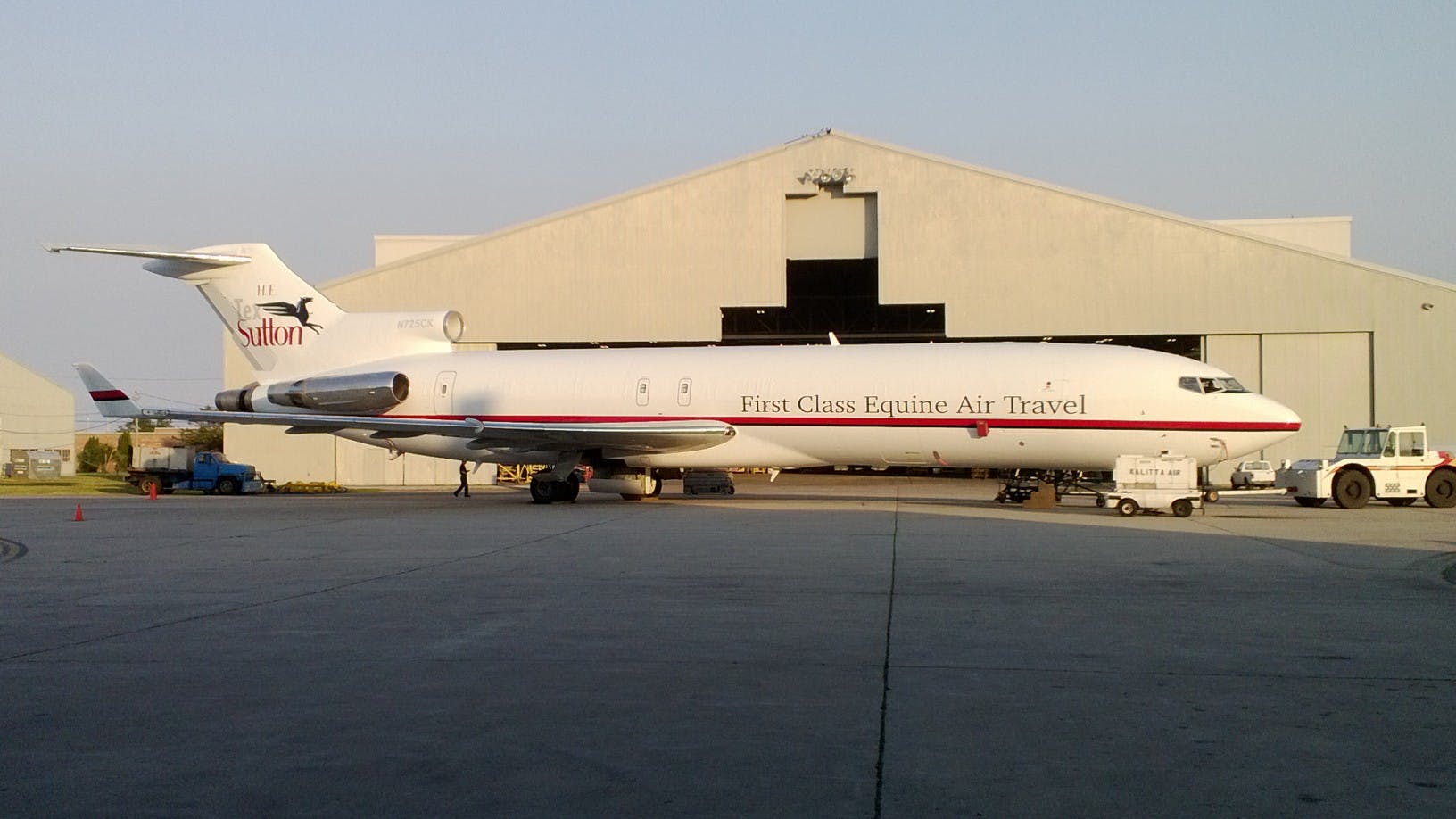
Much like Boeing airliners can be reconfigured on the inside to create a supersized private jet called a Boeing Business Jet, this Boeing 727 has been very specifically outfitted to transport horses.
Air Horse One accommodates up to 21 prized thoroughbreds, quarter horses, show jumpers, eventers and dressage horses. From the extra large cargo door and padded stalls; to the hay and water sources, this aircraft has one of the most unusual interiors in aviation.
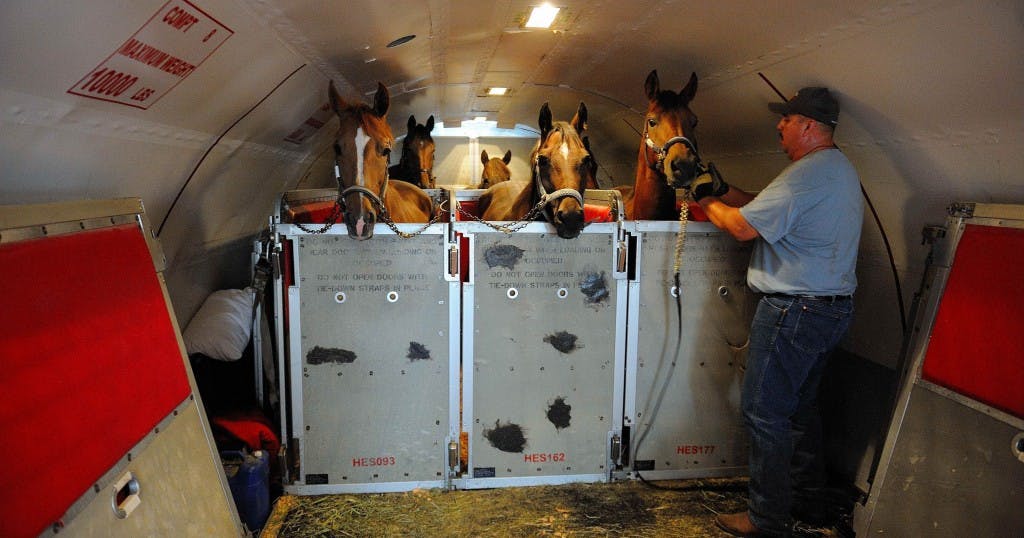
In addition to the horses themselves, there’s space on board for their trainers and groomers.
And while it may seem like the height of pampering to fly a horse on a private aircraft, it can make a world of difference to a race horse’s wellbeing to move them from A to B as quickly as possible. When long distances are involved, the stress of a multi-day trip in a horsebox can take a big toll, versus just a few hours in the air.
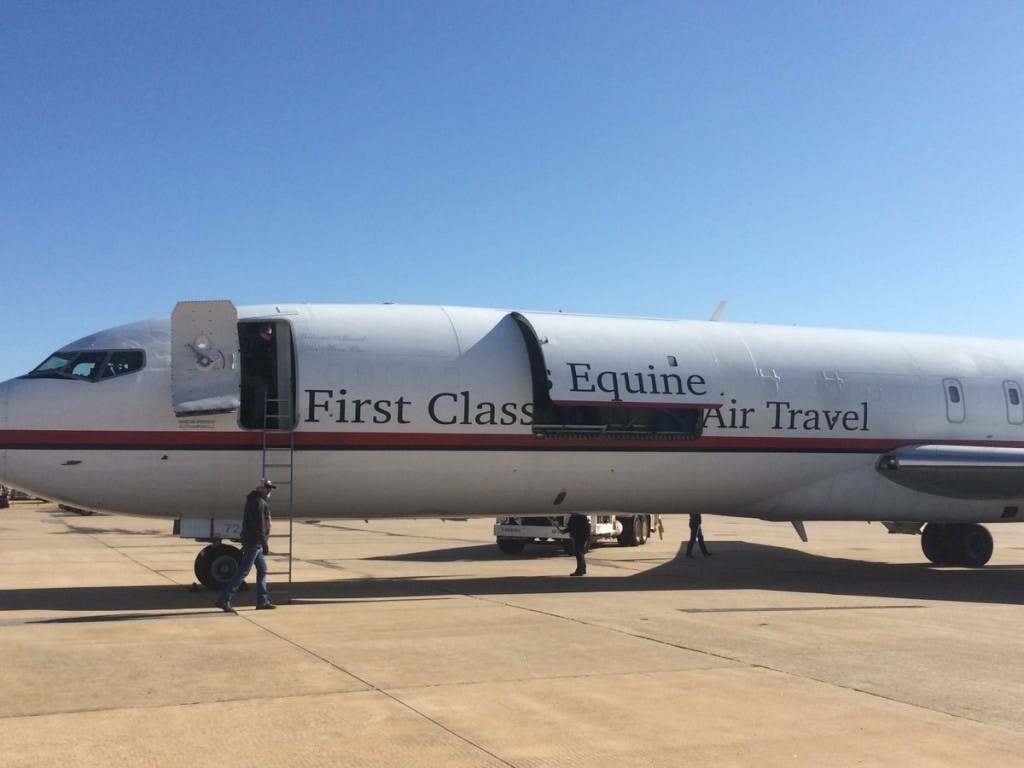
And when you consider the huge prizes these horses are able to win at races, and how much investment (and dedication) is put into their breeding and training, the average $3,150-$5,000 flight cost per equine passenger is put into perspective.
The main concern when flying horses is to make sure they drink more than they would on the ground as, just like humans, they can become dehydrated more easily in the drier air. So the aircraft has to carry a lot of water onboard.
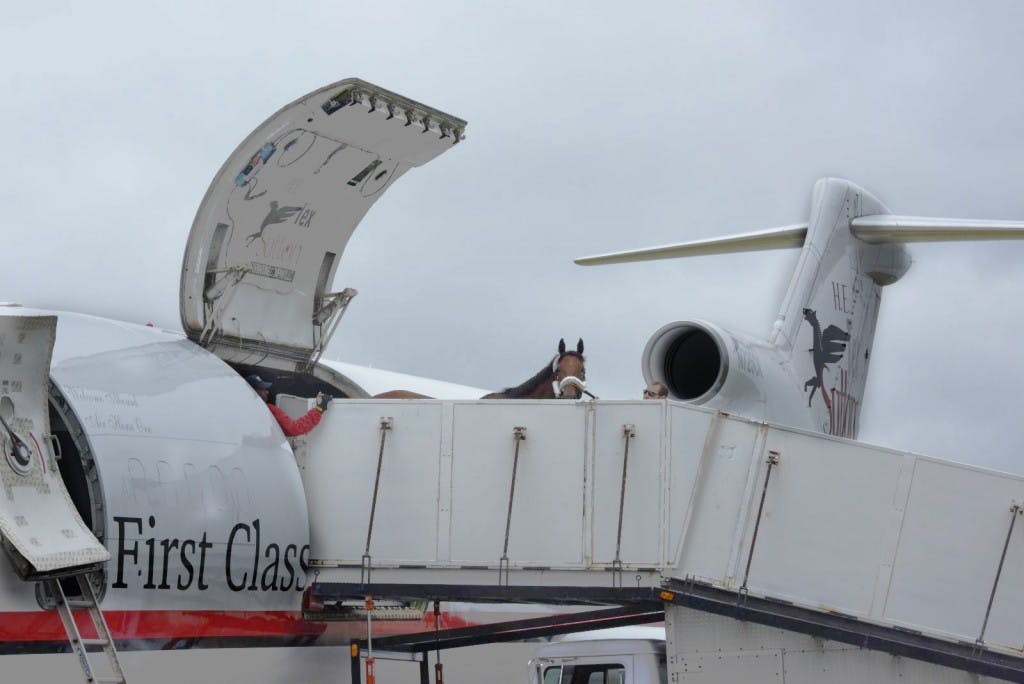
Air Horse One is used mainly for domestic US travel as quarantine restrictions can limit horses’ international travel, but they do occasionally fly further afield.
For any private jet charter advice (including flying with your pets) contact us or call 24/7 on +44 (0)20 7100 6960 .
Related content

Music & entertainment industry charter

Funeral For Saudi King Abdullah Sees World Leaders Flying Into Riyadh

A private jet birthday card for Prince George
- January (76)
- February (72)
- August (52)
- air passenger duty (8)
- air traffic control (22)
- aircraft (734)
- aircraft manufacturers (163)
- airlines (92)
- airports (233)
- aviation history (32)
- awards (26)
- business aviation (1)
- business travel (78)
AIR HORSE ONE: On Board The Custom Aircraft That Transports Million-Dollar Racehorses
Ever wonder how a million-dollar racehorse gets from point A to point B?
One way is in a custom Boeing 727 aircraft that transports about 2,300 horses around the country each year, according to the New York Times.
The horse-friendly jet is owned by H.E. "Tex" Sutton Forwarding Co., a Kentucky-based horse transportation company that " provides first class equine air travel" to valuable racehorses and beloved family pets.
The company was founded in 1957 by horse-loving Texan Halford Ewel ("Tex") Sutton, and although Mr. Sutton has since passed away, the business is still going strong: depending on the length of the trip, transporting one horse can cost between $3,250 and $4,950.
Horses can travel in style on a Boeing 727 run by Kalitta Charters, H.E. Sutton's partner. The aircraft has a custom interior and is dedicated solely to transporting horses.
Custom designed walk-on ramps ensure that the horses never have to set foot on the tarmac.
The planes are climate-controlled, and each horse is provided with individual food and beverage service (hay and water) throughout the flight.
Horses are loaded one at a time, and the flexible stall system allows each stall to be contracted around the horse after it is loaded, making the most effective use of the space inside the aircraft.
Each flight can carry up to 21 horses and their accompanying equipment, and grooms or assistants can accompany their horses if they'd like.
Pilots avoid steep ascents and pride themselves on smooth, uneventful landings. They'll fly out of their way to avoid rough weather so as not to frighten the horses.
Now see a cushy plane for humans
Tour The Amazing $64.5 Million Gulfstream G650 >

- Main content
APOLLO EQUINE

equine air transportation
Apollo equine can oversee the entire horse transportation process.
There's a big difference between horse air transportation and horse ground transportation. Equine air transport is complex and much more intensive: additional paperwork is required; stringent legal requirements are in place and must be met; greater manpower is invested per horse shipped. Mistakes are costly.
SHIPPING YOUR HORSE BY AIR IS OUR SPECIALTY.
With experience shipping hundreds of horses by air, Apollo Equine has streamlined this process. We've got experience dealing with almost every scenario imaginable. Our experience and expertise include both the international importation of horses into the U.S. and the exportation of horses to other countries, as well as domestic air transport throughout the country.
But we are more than just air transport. Through our affiliations with ground transport specialists both in the U.S. and overseas, we offer seamless, barn-to-barn service.
Click below to learn more

We’ve had the pleasure of transporting racehorses, show horses, and family pet horses.
We’re excited to help you ship your horse!

Apollo Equine specializes in the importation of horses into the USA, principally on the West Coast, but we can also assist for imports into the East Coast. The entire import process is the same for any horse but the logistics are different depending on the country of origin. We work with a number of agents around the world. As a team, we can help organize your trip from the stable of origin, the flight to the USA and the importation, through quarantine and - if requested - delivery to your barn.
Stall Options:
Horses are flown in jet stalls. These stalls can accommodate up to three adult horses. If you are importing foals, weanlings or yearlings, you have the option of flying 4+ young horses (yearlings or younger) depending on their size. Of course, the airline will have the final say for the horses' safety.
Most horses are flown in a triple (single stall). Your horse would fly with two other horses. This is the least expensive option, also known as “economy class”.
If you would like for your horse to have more room and travel more comfortably on his/her flight, please consider flying in a stall and a half (double stall). Your horse would fly with one other horse. This option costs more but your horse would very much appreciate flying “business class”.
The Details:
All horses are accompanied by a professional horse attendant. Having an experienced horse handler attend to the horses during the loading, flight and offloading process is very beneficial for the safety of the horses, as some can become very restless and endanger themselves and/or others.
We make all necessary arrangements in Los Angeles for you. These include standard import quarantine, USDA monitoring, USDA lab testing, USDA import permits, transportation from aircraft to quarantine, accredited private veterinarian for blood draw and medical treatment if necessary, transfer of blood from Los Angeles to NVSL in Ames, Iowa, customs clearance, equipment pick up from airline, vanning to final destination and CEM quarantine reservations. We, Apollo, are always present at every import into the U.S. and ensure that the horse is put into quarantine safe and secure.
To learn more about the import process and requirements, read or download our fact sheet:
Each country of destination has their own health requirements we must meet before your horse can fly. We work along with your veterinarian to schedule pre-export quarantine, blood draw & testing, check vaccination records, and help prepare all international health papers. All health papers must be pre-approved before being endorsed by the USDA. We make the booking with the airline, we can organize transportation to the airport, get your health papers endorsed by the USDA, personalize the care of your horse and coordinate with the import agent in your country of destination.
Horses are flown in jet stalls. These stalls can accommodate up to three adult horses. If you are importing foals, weanlings or yearlings, you have the option of flying 4+ horses (yearlings or younger) depending on their size. Of course, the airline will have the final say for the horses' safety.
Most horses are flown in a triple (single stall). Your horse would fly with two other horses. This is the least expensive option also known as “economy class”.
To learn more about the export process and requirements, read or download our fact sheet:
Air transport.
Apollo Equine offers domestic flight shipping for your horse(s). As with international flying, we can also assist with ground transportation to and from the airport.
Your horse(s) can be flown in either a single or stall and a half to any destination within the continental U.S. via FedEx.
Two grooms are required by FedEx, but we always advise that one is a professional groom and the second can be your personal groom. All grooms must be cleared through FedEx, a process that can take up to three months.

Plane forced to return to JFK Airport after horse on board gets loose
The cargo jet had ascended 31,000 feet, according to FlightRadar24.
A 747 cargo plane heading to Belgium from New York was forced to return to John F. Kennedy International Airport after a horse escaped from its stall, according to the air traffic control audio.
According to the audio clip, which was obtained by You Can See ATC via Live ATC, the horse got loose within 30 minutes of takeoff.
The Boeing 747 was barely at 31,000 feet when a pilot told air traffic control that a horse had escaped from its stall and that they needed to return to JFK on Thursday, according to FlightRadar24.

In the air traffic control audio, a pilot is heard saying, "We are a cargo plane with a live animal, a horse, on board. The horse managed to escape its stall. There's no issue with flying, but we need to go back to New York as we can't resecure the horse."
The flight was forced to make a U-turn off the coast of Boston and dump about 20 tons of fuel over the Atlantic, "10 miles west of Martha's Vinyard," due to the flight's weight, according to the audio.
Amid the fuel dump, the pilot requested a veterinarian to be present at JFK when the plane arrived.
MORE: Mom says airline allowed unaccompanied daughter to exit plane alone after flight
Once landed, when ATC asked if the flight required assistance, "On the ground, negative. On the ramp, yes, we have a horse in problem."
It remains unclear how the horse managed to escape but it remained unrestrained until the plane landed at JFK, according to the audio.
The flight was able to take off a short time later and successfully arrive at Liege Airport on Friday morning, according to FlightRadar24.
Air Atlanta Icelandic, the charter airline operating the flight, did not immediately respond to ABC News' request for comment.
ABC News' Sam Sweeney contributed to this report.
Related Topics
Trending reader picks.

Secret Service saw shooter on roof before gunfire
- Jul 17, 7:02 PM

Trump shooter was seen with bag, range finder
- Jul 18, 11:01 PM

IT outages reported across globe

Trump classified documents case dismissed
- Jul 15, 5:29 PM

Assassination attempt at Trump rally
- Jul 14, 11:49 AM
ABC News Live
24/7 coverage of breaking news and live events
Other FreightWaves Products
- FreightWaves
- American Shipper
- Modern Shipper
- Ratings.com
- FreightWaves TV
- Newsletters
- FreightCasts
- Whitepapers
- Advertise with Us
- FreightWaves Ratings
- State of Freight Insights
- Global Supply Chain
- FreightWaves Classics
- Blockchain News & Updates
- Legal issues
- Sustainability
- Company Earnings
- Truck Driver Issues
- Trade and Compliance
- Shared Truckload
- Insurance & Risk Management
- Optimizing Fleet Compliance
- Recruiting Rundown
- Smarter Capacity
- Reinventing Freight Procurement
- Carrier Cyber Security
- Logistics/Supply Chains
- Freight All Kinds
- Trucking Regulation
- Last-Mile Delivery
- OEM Trucking
- Trucking Equipment
- Parcel Freight
- Container Shipping
- Borderlands: Mexico
- Borderlands: Canada
- Freight Industry White Papers
- Chart of the Week
- Shippers Perspective
- FW Pricing Power Index
- Energy Industry
- Weather and Critical Events
- Inside SONAR
- What the Truck?!?
- Sense per Mile
- FreightWaves NOW
- Fuller Speed Ahead
- Net-Zero Carbon
- Rethink Reshoring
- Great Quarter, Gals
- The Stockout
- Loaded and Rolling
- Running on Ice
- Freightonomics
- Put That Coffee Down
- Taking the Hire Road
- Drilling Deep
- View All Newsletters
- FreightWaves Daily
- FreightWaves Best Of
- AS Week In Review
- The Stockout (CPG & Retail)
- Running on Ice (Cold Chain)
- What The Truck
- Check Call (3PL News/Analysis)
- Loaded & Rolling (Enterprise Fleet News/Analysis)
- Ocean Cargo
- Value Based
- Request a Demo
- SONAR Knowledge Center
- SONAR API Explorer
- Future of Supply Chain
- F3: Future of Freight Festival
- The State of Freight Webinars
- FreightWaves TV Events
- Freight Sentiment Indexes
- FreightWaves Academy
- Carbon Intelligence
- Public Companies Directory
- EV Directory
- AV Directory
- FreightTech
- Shipper of Choice
- Infographics
- Market Experts
- Online Haul of Fame
- Benchmarking
- Our Mission
- Executive Team
- Editorial Team
- Our Investors
- Reindustrialization
That horse can really fly!
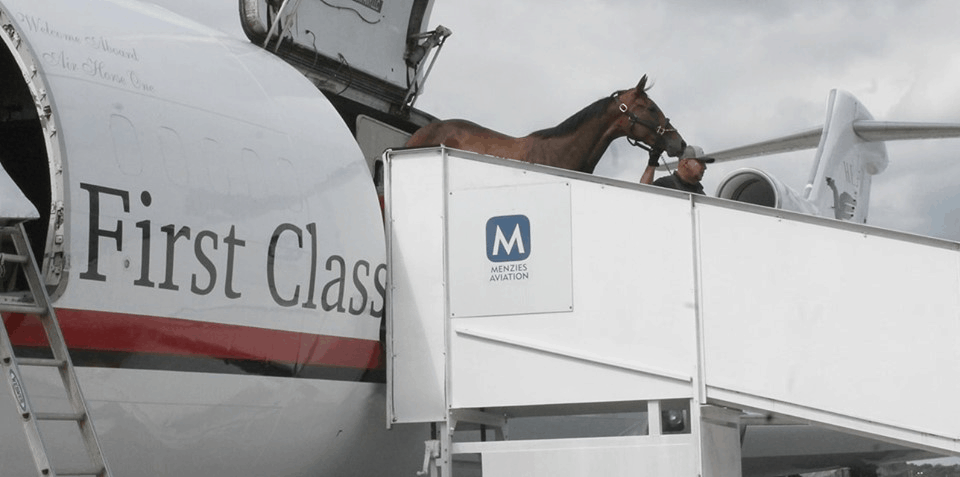
Horses are among the most prominent live animals moved by air on an ongoing basis. They fly both domestically and internationally, and in some cases, almost as much as some frequent flyers! There are thousands of horses moved by air each year. Why ship horses by air? The main reasons include major races around the U.S. and abroad for racehorses, shows and exhibitions for show horses and specialty breeds like Arabians, rodeo events, polo matches, relocation of mustangs, and changes in seasons to take advantage of the best weather for feeding and breeding. On this latter point, there are regular annual moves of horses at different times of year between Argentina, Florida, northern Europe and the Gulf region, and between the southern U.S. states like Florida and northern states.
Live animal transportation is one of the most complex and growing specialty areas within air cargo. This specialty covers a wide range of air transport needs, including moving household pets, animals for zoos and aquariums, livestock, breeding stock, live tropical fish, resettlement of animals, and animals for shows, races and competitions.
Specialized logistics industry
A whole specialty logistics and forwarding industry has emerged to handle the stable-to-stable needs of moving horses by road and by air safely, economically and in compliance with all applicable live animal regulations. Within the U.S. there are several companies that provide their own specialized vehicles and drivers for transporting horses over-the-road, and to and from major airports for air transport. These companies include names such as Brook Ledge Horse Transportation, Equine Express and Lazcar International. Others such as the Dutta Corporation, Horse America and Equiflight specialize in international forwarding, handling the complexities of arranging transportation on all legs, export and import documentation, health certificates, quarantines, provisioning of animal attendants, etc.

When shipping a horse on a U.S. domestic or trans-border U.S.-Canada move, what drives the decision on whether to truck or fly a horse? Two-person team drivers are almost always the rule for transporting horses any distance by truck, enabling the fastest transit times while minimizing stress on the animals. A cross-country run to the West Coast is a three to three and one-half day venture. Most vans are air-ride trailers equipped with a variety of customizable stall configurations, including single stalls, double stalls and box stalls accommodating up to three horses. Many have closed-circuit camera surveillance systems for drivers to continuously monitor horses and take action should they see problems with an animal, including contacting local veterinarians en route.
A company such as Brook Ledge Horse Transportation configures its own trailers in Florida and builds in stress-reducing measures such as wide doors, lower ramps for ground loading, insulated trailers, kick pads and fan and window placement for improved ventilation. Drivers are often recruited from within the equine industry which seeks “horsemen” with a good feel for each animal. Fresh hay, shavings and water are prescribed on a set schedule, and horses are given regular rest breaks every three to four hours. Despite these comforts for a long road trip, the decision to fly comes down to specific event schedules, the value of the horse and owner preference.

Flying horses domestically
For U.S. domestic air transportation of horses, there are only two airline choices available. FedEx accepts horse bookings through its Live Animal Desk. Shipments typically need bookings a minimum of 48 hours in advance, and health certificates on the animals must be presented for horses to fly. Grooms, or attendants for the horses, must accompany the animals on the flight to care for the animals along the way, replenish food and water and ensure their comfort. FedEx allows two grooms per flight, each of whom must be on a pre-approved FedEx list of grooms for security reasons. The horses are loaded into specially equipped airline horse containers at the airport and raised onto the main deck of the aircraft using a loader with a scissor lift. Each container has partitions enabling one, two or three horse stalls per container, depending on the size of the animal and owner preference. They fly on the same FedEx schedules and flights as packages and make the same transfers at FedEx hubs. One major shipper using FedEx noted he uses one groom for every two horse pallets, suggesting that four-horse containers containing eight to 12 horses (i.e. two to three horses per container) would be the maximum flown on any given FedEx flight. FedEx flies horses year-round, with the exception of the Christmas holiday peak season, which is between December 5 and January 7.

A second option, often used for racehorses moving from track to track during racing season, is the H.E. “Tex” Sutton Forwarding Company, which markets a single Boeing 727 freighter, nicknamed “Air Horse One” capable of carrying up to 21 horses in stalls. In chartering with Tex Sutton, the aircraft flies with its own complement of company animal handlers to look after the horses, but additional grooms can be supplied by the horse owner(s) or charterer if more personalized care is required. The operator of the aircraft is Kalitta, a well-known certificated U.S. air carrier. This is essentially a charter flight scheduled around the horses’ needs. The 727’s lower height features “walk on” loading ramps that let horses walk more naturally directly from their delivery van onto the aircraft and into their stall, and the same in reverse. The aircraft’s stall system is modular, allowing partitions to be built around each horse as they are loaded onto the aircraft, including full box stalls for mares and foals or weanlings flying together. Tex Sutton Forwarding is based at the Lexington, Kentucky airport (LEX).
International shipment complexity
Shipping horses internationally is a much more involved process. Individual country requirements for animals exported and imported vary, and quarantines of varying lengths of time are normally mandated at both origin and destination, and sometimes at transit points, adding time and cost. Coordinating all of the surface and air transportation, quarantine stays, health certificates, bloodwork, veterinary clearance, customs clearance for export and import, and transit documentation is all part of the forwarding role. Horses now increasingly need passports to be able to compete in many events, such as show events of the International Federation of Equestrian Sports (FEI), and to be able to travel and transit Europe and other international points. The United States Equestrian Federation (USEF) can issue horse passports within the United States to U.S. citizens, subject to other qualifications also being met.
Horses travel only on the main deck of an aircraft, which generally means all-cargo freighter aircraft. Several major freighter airlines that provide specialty cargo services for international horse transport include Cargolux, Cathay Pacific Cargo, Emirates SkyCargo, Etihad Cargo, FedEx, KLM, Korean Air Cargo, LATAM, Lufthansa Cargo, Martinair, Nippon Cargo Airlines and Qatar Cargo, among others. An exception to this is KLM, which operates 747-combi aircraft on some routes where cargo such as horses are loaded in the rear portion of the aircraft on the main deck, separated from the passenger compartment by a bulkhead. So it is actually possible for horses and their owners to travel together on the same flight.
For airlines, equine moves can mean a routine booking for a few horses flying on a scheduled flight alongside other cargo, a full charter operation for the horses only on an existing or completely new route, or a part-charter operation where there is sufficient load to reroute a scheduled freighter operation to pick up or unload.
Specialized airline horse containers
Horses on these aircraft travel in specially designed equine containers with designators such as HMJ, HMC, HMA or other “HM” code that are constructed with non-slip floors, adjustable ventilation and lighting apertures, and groom/vet access panels. Horses are loaded into the container at the airport animal facility or nearby quarantine facility and brought planeside. These containers each have a 125 x 96-inch pallet base that is raised to the aircraft’s main deck level using a maindeck loader, rolled onto the aircraft and locked into the aircraft floor system. They can be configured in an “economy class” configuration for three horses each no wider than 22 inches at their widest point, or a “business class” configuration for two larger horses, or a “first class” configuration of one horse per stall. Generally, airlines charge per container, so the “first class” configuration would be three times as expensive per horse as “economy class.”

Aside from the fully rigid HMJ unit, some airlines feature variations on this including “droptop” (HMA) and collapsible containers (HMC). Getting a sufficient supply of horse containers to an origin to accommodate horse bookings is a big and potentially expensive logistics challenge for airlines. Droptops allow the container height to be reduced to a 62-inch aircraft lower deck height, facilitating container repositioning via either passenger or freighter aircraft, or used there for smaller animal shipments such as goats or sheep. Collapsible stalls allow for easier positioning and repositioning through stacking multiple units together and using the lower deck on either freighter or passenger flights. There are also HAY containers with a different contour that can transport up to three horses on Boeing 737 freighter aircraft operating regionally in Europe, Asia and other parts of the world.

Boarding and care enroute
The horse boarding process onto a flight is a careful choreography among airlines, ground handlers, quarantine centers, grooms, forwarders and trucking companies to ensure horses meet the departing aircraft with a minimum of waiting time either planeside or onboard the aircraft prior to departure. Grooms must undergo the same passenger security screening and exit clearance to board a freighter aircraft (done at the cargo handling facility) as normal passengers do in the passenger terminal. Airlines want to avoid costly delays on the ground, and animal handlers want to minimize undue stress on the horses. But as all travelers know, mechanical, weather and other delays can occur, so contingency plans must be in place with all parties. Pilots are always pre-advised when live animals are onboard and do what they can to expedite on-time departures and takeoffs.

Cargolux states that its largest aircraft, the Boeing 747-800 freighter, can carry a maximum of 90 horses, loaded three per pallet across 30 pallets, and its 747-400 freighter can handle 84 horses. The other industry freighter workhorse, the Boeing 777 freighter, can accommodate 81 horses.
However, seating capacity for grooms is also a factor in choosing a carrier for a large number of animals. The 747s typically have five seats available for grooms, while the 777s have between five and 11 seats, depending on the airline. In the case of the 747 with five seats, one forwarder advised his maximum shipment size would be 15 pallets, or up to 45 horses, while a 777 freighter with more seating for grooms could handle a much larger number of horses. The seating areas of freighter aircraft have access to the aircraft’s main deck for grooms to check on their passengers.
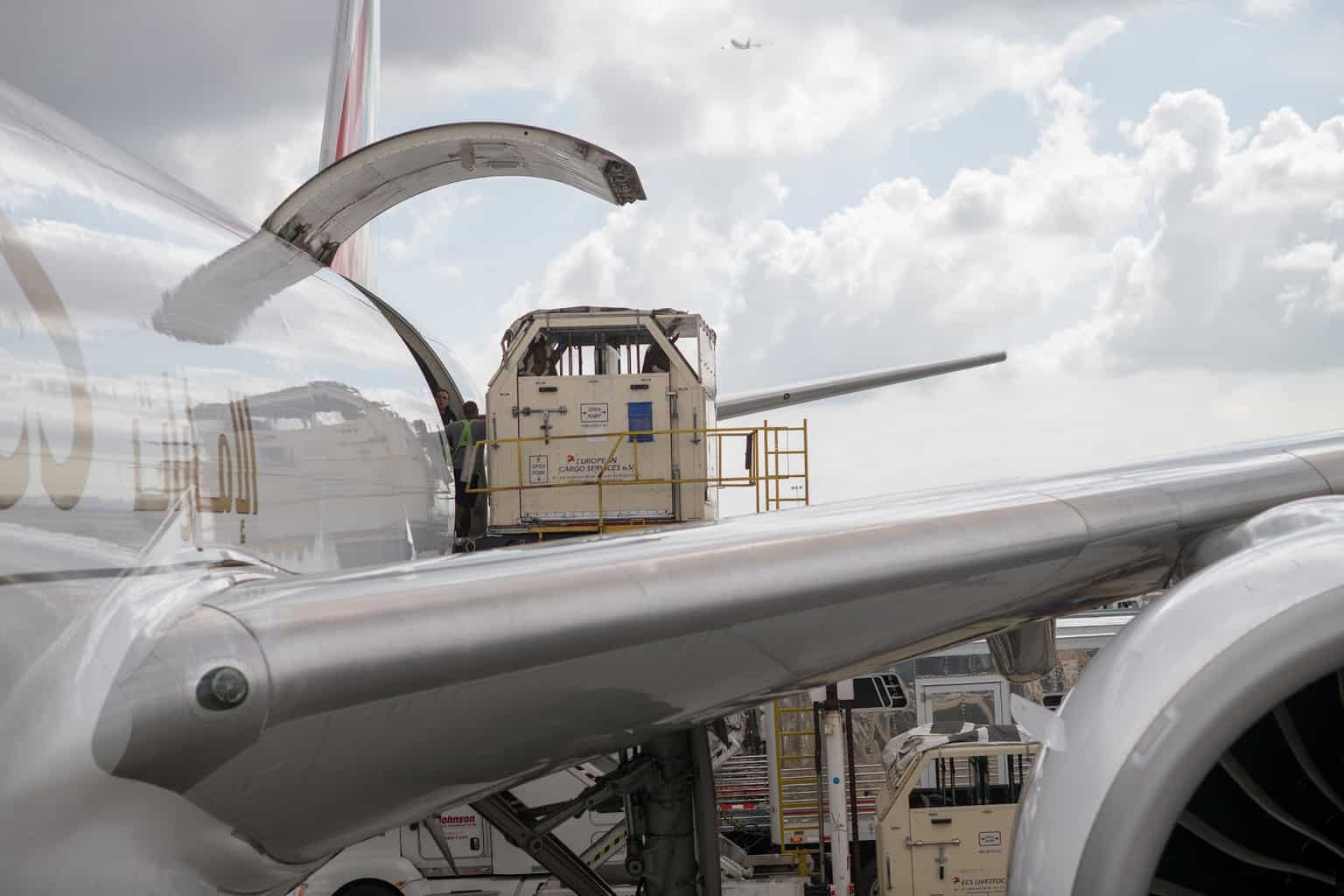
Tim Dutta of the Dutta Corporation noted that racehorses, show horses and polo horses are like high-performance athletes on the road that follow a certain regimen. He views horses as just as individual as human beings in their behaviors and attitudes towards flying. Some are experienced “road warriors” traveling around the earth as often as five times in a year, where others are nervous and need calming. It’s the job of the grooms to “read the horse” while boarding and in-transit, and provide tailored care and reassurance to minimize stress. Hay and water throughout flight are standard offerings. Owners and veterinarians dictate the rest of the feed, depending on the animal. Silage, electrolytes, vitamins and carrots are all options available for use, depending on the horse. Sedation of an upset horse is considered as a last resort, only to be used when the safety of the animal or others on board is at risk.
Major airlines all follow the International Air Transport Association (IATA) Live Animal Regulations in handling and caring for horses to ensure their comfort and safety. They are usually loaded last and unloaded first. They always fly facing forward, never aft. Wilfred D’Souza, who manages the equine product at Emirates SkyCargo, notes that they avoid loading horses near other animals as well as avoiding loading perishables on the same flight. No tasty temptations for the animals! In flying, most airlines reduce the stress by keeping the compartments the animals are in well-ventilated and ambient temperature cool, around 17C degrees (63F). Pilots try to avoid turbulence, sharp descents, turns or ascents that could unnerve their equine passengers.
Horse shipping and transit centers
Airlines and airports in major transit centers have invested in state-of-the-art animal handling and transfer facilities in locations such as Frankfurt, Amsterdam, Luxembourg and New York (JFK). These are equipped with 24-hour veterinary care and quarantine facilities. Lufthansa Cargo proudly points to its Frankfurt Animal Lounge with 42 15 x 20-foot horse stalls, full veterinary services, documentation checks and three hours minimum transit capability. New York recently opened the Ark at JFK to provide similar care and quarantine services for horses and other animals transiting JFK. Dubai features a permanent horse ramp to ease stress for the animals while moving from trucks to airline containers.

For shipments arriving in the U.S. there are only four gateways that have U.S. Department of Agriculture (USDA) staff dedicated to handling importation of horses, which include New York (JFK), Chicago (ORD), Los Angeles (LAX) and Miami (MIA). These same four airports can handle equine export shipments, along with Atlanta (ATL), Houston (IAH) and Columbus Rickenbacker (LCK). U.S. horse shipments by air were valued for Customs purposes at a total of $400 million in 2018, with major destination markets of the U.K., Ireland, France, Japan and the United Arab Emirates. Inbound shipments in 2018 were valued at $528 million, with Germany, the Netherlands, Ireland, the U.K. and Belgium shipping the most to the U.S. New York is considered the largest year-round transit point in the U.S. for horse movements. Miami has large seasonal inbound horse movements in late fall and export movements in early spring, while Chicago typically exports in late fall before cold weather sets in.

And after all is done and animals safely unloaded and transported to designated airport animal or quarantine facilities, there’s just a bit of cleaning up to do! Stalls and aircraft areas used by horses are cleaned and disinfected, stray hay removed and water leakage dried up. For the airlines, it’s a demanding product that needs personalized service and attention, but done well, earns repeat business year-round that yields high returns.
FreightWaves Staff

- Forum Listing
- Advanced Search
- Keeping and Caring for Horses
- Horse Health
They put down horses on planes if they act up?
- Add to quote
my friend said that if a horse freaks out on a plane, they put it down because, if it panics enough, it could crash the plane. So if the horse freaks and they can't control it, sedate it, they put it down. is this true? I don't believe it.
I don't believe it either. I couldn't imagine spooks gotta whiz being PTS because he wouldn't settle down. I would imagine they would be given a sedative first, if they already don't get a horsey Xanax. Posted via Mobile Device
Yeah, horses have occasionally been put down due to 'going berserk' on planes, but it's not due to safety of the plane, but of the horse - eg. they're unable to be tranqued, hurt too badly, freaking out other horses dangerously...
Agree with loosie, I am sure it has happened but can't see it being because of "a danger to the plane". It's probably similar to your hamster getting loose or going berserk in the car lol (well not quite but you get the idea!) I can imagine if the horse is literally in a blind panic and hurting itself, or has caused an irrepairable injury that it make be necessary but obviously everything is done to prevent that. Particularly as it is very very valuable animals flying and not usually Joe Blow's backyard nag. If you have a 6 figure (or more!) self destructive item, you will do everything you can to care for it and to prevent if from self destructing! As said they have grooms with them at all times. Interesting article! Thanks for the info!
It has happened. Some horses simply cannot tolerate flying. Know how your ears will pop at altitude? Some horses, and some people can't get that pressure relief (I'm one of them) and it becomes quite painful.
Years ago horses would have been put down on the plane - but with the way things have progressed (medically, with the transport system, ect) it would be VERY rare that this would happen now. From my understanding, and knowing people who are pro-grooms that travel often, the horses travel just as quietly on a plane as they do in a horsebox. We travel horses internationally for racing, and every single one of them has handled it perfectly fine and returned safely.
If memory serves me correctly it was a Walt Disney movie years ago where this was depicted. It wasn't that the horse was going beserk, it was rearing just a little but of course a lot of drama was built up around this.
I think International Velvet is the movie that sticks in my head for showing this?:?
It was International Velvet, and the incident was based on a very real incident that happened to an Olympians horse, Michael Plumb, while traveling to Tokyo for the Olympics. Michael Plumb - Wikipedia, the free encyclopedia
According to that article it occurred in 1964, so those who said that this is not a modern issue except in unlikely cases of extreme injury are probably right on. Not only were planes much less advanced fifty years ago but also the methods of securing the horses were probably nowhere near as good as the modern containers.
Perhaps, if you can afford a box or enclosed stall, but most still travel like this Inside Plane That Transports Racehorses - Business Insider a panicked horse (and I mean truly panicked, not just afraid) could tear that plane to pieces and worse, get all the other horses equally panicked. That was the problem, not 1200# of panic, but 7200# or more depends on how many horses you have. I will say, though I don't know, is that I'll bet modern medicines have changed enough so the potential for such circumstances have drastically been reduced. Easier to calm and sedate them if they do get twitchy.
I don't know about that linked site but my horses travelled in 'crates' like the one PrivatePilot showed. They're really strong and no way could a horse kick through one and damage a plane. They also aren't big enough for the horse to move around a lot The biggest danger would be to themselves if they went down and got wedged but the groom has permission from the owners to sedate - hopefully before that happened. Not sure how you would euthanize a horse on a plane. This is a link to the company we used to bring our horses from the UK to the US and their is quite a lot of info on the site IRT - International transport of horses
It seems unlikely. A panicked horse will make other horses nervous sure, but with handlers in the area it's unlikely that one panicked horse would get the other horses worked up to that point. It's probably more that a horse at THAT point would be a danger to itself. Neat article.
I would think that if it happened very often, horses wouldn't be shipped- period. Airlines don't want to have to deal with such an issue and the liability of it. I am sure it is the exception not the norm.
I doubt the airlines would want to contend with the PR nightmare OR the insurance payout for animals whose values go into the 6-7 figure range and up to put them to sleep. It's likely that a horse is probably tranquilized prior to even boarding the plane, but once in the air it's probably a smoother ride than being in a trailer.
It has all changed a great deal. At one point the stalls the horses stood in were narrow and not very high, coming only about half way up their sides. Also tranquillisers have great.y improved. At one point if you gave a horse a tranq. when it was already het up, it often made them worse. Much has improved.
I agree it would be rare, but understandable if a horse going berserk could threaten the lives of the other passengers. Really no different than if a passenger went berserk. Great photo by PrivatePilot.
Horses are now loaded on the ground in specially designed stalls that are rolled up the ramp onto the plane. There is no way a horse could break out of one of these. They are well padded for the horse's protection.
An Olympic horse in 1964 was euthanized on a plane. It was Michael Plumb's event horse Markham, I believe they actually shot him, and it was because he was posing a danger to the plane.
- ?
- 94.3K members
Top Contributors this Month
Watch CBS News
Firefighting pilot killed in small plane crash in Montana
July 11, 2024 / 12:00 AM EDT / CBS/AP
A pilot died when a single-engine firefighting aircraft crashed into a Montana reservoir Wednesday afternoon while scooping up water to fight a nearby blaze, officials said.
The crash was reported shortly after noon on Hauser Reservoir on the Missouri River northeast of Helena in Lewis and Clark County.
Law enforcement and search and rescue teams in boats responded, along with divers from Gallatin County.
Officials said later in a news conference that the "scooper" plane's pilot, a 45-year-old woman, died. They did not provide a name pending notification of next of kin who do not live in the United States, the Independent Record newspaper reported.
"This is not just coming in and flying and picking up water. These are dangerous types of environments," Lewis and Clark County Sheriff Leo Dutton said.
The Federal Aviation Administration, the National Transportation Safety Board and the U.S. Forest Service will investigate the crash of the Air Tractor AT-802, which was working for the Forest Service and contracted out of Idaho.

The pilot was part of a crew fighting the nearby Horse Gulch Fire, a 600-acre human-caused blaze burning in dense timber in the Helena-Lewis and Clark National Forest about 5 miles south of the town of York. The fire started Tuesday, and the sheriff's office ordered some residents to evacuate Wednesday afternoon. The fire has no containment.
"We are deeply saddened to learn of the passing of the young female wildland firefighter who tragically lost her life responding to the Horse Gulch fire in Helena, Montana," Montana Gov. Greg Gianforte and Idaho Gov. Brad Little said in a joint statement. "Our first responders and wildland firefighters put their lives on the line to quickly respond to threats and protect our communities. It's a true act of bravery to run toward a fire."
High temperatures in the Helena area have been above 90 degrees Fahrenheit for several days and were forecast to reach 100 degrees on Wednesday.
More from CBS News

U.S. journalist Evan Gershkovich's trial resumes in Russia on spying charges

Trump's 17-year-old granddaughter says it was "heartbreaking" when he was shot
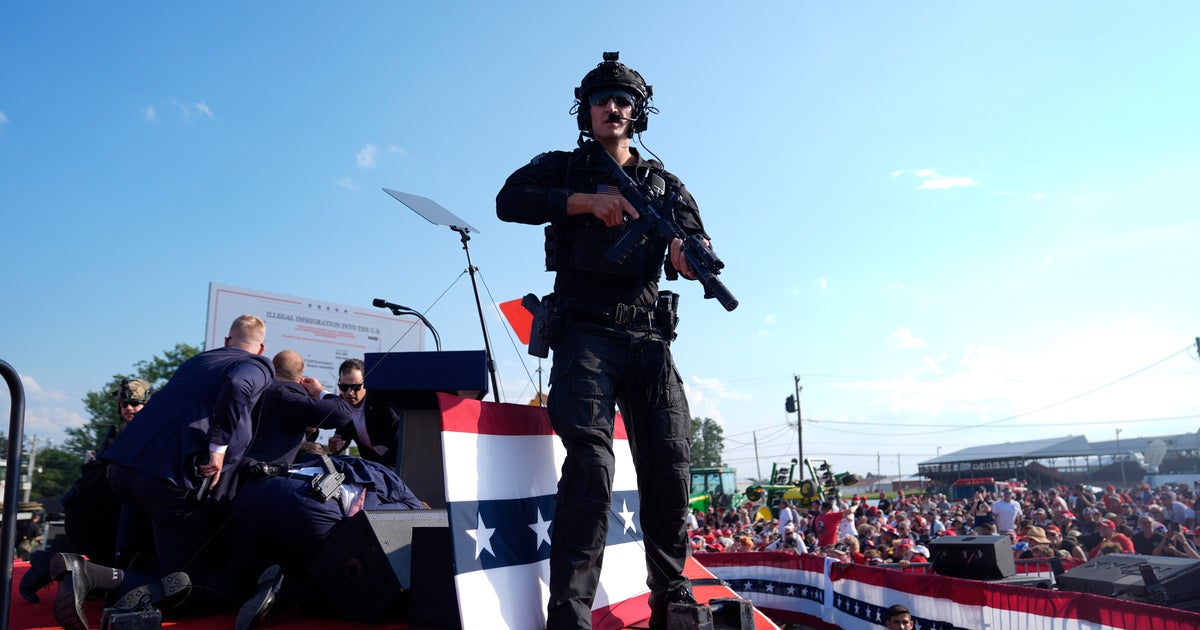
Sniper took picture of Trump rally shooter before attack, source says

Stegosaurus sells for record $45 million at Sotheby's auction
Watch: American Airlines plane loses tire during takeoff, fire ignites on Florida runway
The flight was taking off in tampa and was supposed to go to phoenix before the tire blew out and caused a fire. it's just the latest in a number of such incidents..

An American Airlines plane blew a tire upon takeoff and caught fire in Florida on Wednesday, the latest of multiple such incidents.
The flight, which was taking off from Tampa and headed Phoenix, was delayed after the "mechanical issue" on the runway right before takeoff, airline spokesman Alfredo Garduño told USA TODAY on Wednesday. The issue, according to Garduño, involved Boeing 737-800 tires.
Emergency responders responded to the scene just before 8 a.m. after receiving word that a tire had blown off and caught on fire, Tampa International Airport spokesman Joshua Gillin told the Tampa Bay Times.
Everyone on board, including 174 passengers and six crew members, were "safely deplaned and were bussed to the terminal," Garduño said. No other flight operations were affected by the incident, the Times reported.
All passengers were rebooked on other flights to Phoenix.
"We never want to disrupt our customers' travel plans and apologize for any inconvenience this may have caused," Garduño said.
Another airline lost a tire recently
American Airlines isn't the only airline reporting a rogue tire. United Airlines also reported a lost tire during takeoff early Monday morning.
A United Airlines aircraft headed to Denver from Los Angeles lost one wheel on takeoff shortly after 7:15 a.m. but managed to land safely at its destination around 10 a.m., USA TODAY reported. No injuries to the 174 passengers and flight crew onboard were reported in connection with the incident, Bloomberg reported.
“The wheel has been recovered in Los Angeles, and we are investigating what caused this event,” United Airlines said. Additional details about the tire were not immediately available.
The lost tire is just one of many incidents disclosed by United Airlines in the past year, which triggered a federal safety review of the carrier. United Airlines is still in a position of "increased oversight" by the Federal Aviation Administration, which was called in to conduct an in-depth examination of the airline’s operations, FAA spokesman Ian Gregor told USA TODAY on Monday.
David Evans, an FAA-certificated airline transport pilot and flight instructor, previously told USA TODAY that the loss of a plane tire is "rare." And that "from time to time, this sort of thing does happen but it's usually uneventful at the end of the day."
- Search Please fill out this field.
- Manage Your Subscription
- Give a Gift Subscription
- Newsletters
- Sweepstakes
- Travel Tips
Is It Better to Sit on the Left or Right Side of the Plane? Frequent Fliers Weigh In
Consider these factors when selecting your seat on a plane.
:max_bytes(150000):strip_icc():format(webp)/Stefanie-Waldek-7eed18a8c9734cb28c5d887eb583f816.jpg)
izusek/Getty Images
Most travelers have a preference for window or aisle seats when it comes to air travel, but have you ever given thought to which side of the plane you should sit on? Now, before we open the floor for debate, let's make one thing clear: One side isn't necessarily safer than the other. However, there are many other reasons frequent fliers might specifically pick either the right or left side. We polled some frequent fliers about which side of the aisle they prefer — here's what they suggest you should consider when selecting your seat on an airplane .
Potential Views
If you prefer a window seat, you might want to check your potential flight path before picking a side. "I really like the window seat and often try and predict which side will have a better view based on the logical flight path into the airport," says Richard Campbell, founder of travel platform 10Adventures . "I still remember my first international flight almost 25 years ago. I was flying into London Heathrow and sat on the right-hand side of the plane, looking out on the Thames and central London as we circled over the city for our approach into LHR. What a way to start a trip!"
Catherine Heald, Asia travel expert and co-founder and CEO of Remote Lands , also prioritizes the view. “For example, when flying from Kathmandu, Nepal's capital, to Paro, Bhutan, travelers want to be on the right side for the best views of Mount Everest," she notes.
But keep in mind that no matter how much research you do, your flight might have other plans. "Even though I try to get a window seat with a great view, it's hard to predict if I'll have great views," says Campbell. "Flight paths change, weather can move in, and what looks good on a map may be underwhelming from 38,000 feet ."
What's Going on in the Sky
It's not all about the view below you. "If I’m flying a polar route, I try to be on the side of the plane that will face north during local nightfall in case I have an opportunity to witness the northern lights," says atmospheric scientist Matthew Cappucci . (Writer's note: I've personally seen the northern lights from planes twice by following this rule.)
But if you're flying on a daytime flight, the sun is a more important consideration. "Since I don’t like having the sun in my eyes, I try to sit on the opposite side of the sun," says Cappucci. "Sitting on the sunny side also means being on the noticeably warmer side of the plane."
Sleeping Preference
Do you tend to lean right or left when dozing off on a plane? If you're one to sleep on planes , you'll probably find yourself leaning one way or another as you drift off. "I prefer the right side of the plane, next to the window, when booking economy. I love looking out the window, but more importantly, I tend to lean to the right when I fall asleep, especially on long-haul [flights]," says Dominika Dryjski, chief operating officer of TravMedia. That said, if you have a lie-flat seat in business class , either side will do just fine.
Related: This Psychologist's Hack for Falling Asleep Quickly on Planes Is so Simple
Right-handedness or Left-handedness
This might be a smaller consideration for nonbusiness travelers, but if you plan on working from a flight, consider your dominant hand. "As a right-handed person, I prefer to sit on the left side of the plane, in an aisle seat, as this makes it easier to work on a laptop if there's work I have to do," says John Lyotier, CEO and co-founder of TravelAI .
At the end of the day, though, there are many other factors for choosing a seat that are more important to passengers than the side of the aircraft. "I care about securing an aisle seat toward the front of the plane and away from the bathrooms, as this will reduce foot traffic in the area, noise, and unwanted smells," says Andy Palacios, VP of growth and strategic partnerships for travel app App in the Air . "Or, if it's a small aircraft and has a 1-2 configuration, I will go for the single seat." And, of course, an upgrade is always a good reason to break the rules, too.
Related Articles
- Mattress & Sleep
- Kids & Baby Gear
- Beauty & Grooming
- Tech & Electronics
The 33 Best Prime Day Travel Deals: Save Big On Luggage, Travel Pillows And More
- Share to Facebook
- Share to Twitter
- Share to Linkedin
Amazon Prime Day 2024 is in full swing, and you’ll find some of the best savings of the summer during the event. If you have a vacation coming up or are a frequent flier looking to upgrade your travel gear, there are some excellent Prime Day travel deals on offer right now—like $125 off this Samsonite Freeform luggage set , 17% off the Apple AirTag and savings of 50% on a memory foam travel pillow . This year, Amazon is even partnering with marketplaces like Viator and Avis to offer deals on tours and car rentals. Along with saving up to 30% off a vehicle for your next road trip, you can snag discounts on experiences like walking tours or pub crawls on your next adventure abroad.
There are plenty of Prime Day travel deals to take advantage of, like over 50% off luggage and other ... [+] steep discounts on travel accessories.
And whether you’re in the market for a new carry-on or a whole set, check out our roundup of the best Prime Day luggage deals for even more discounts. Read on for the best Prime Day travel deals we’ve spotted so far, and don’t miss the rest of the best Amazon Prime Day deals our editors have found across the e-tailer.
The Best Mattresses On Amazon In 2024 To Achieve Quality Rest For Less
The best dyson prime day deals: save on vacuums, air purifiers and more, best prime day travel deals at a glance:.
- Samsonite Freeform Expandable 2-Piece Luggage Set : Now $355, Was $480 (26% Off)
- Travelpro Maxlite Air 25-Inch Checked Hardside Suitcase : Now $150, Was $220 (32% Off)
- Matein Extra Large Carry-On Backpack : Now $28, Was $46 (38% Off)
- Bagsmart Overnight Weekender Bag : Now $18, Was $38 (53% Off)
- Iniu Portable Charger : Now $20, Was $23 (22% Off)
- Apple AirTag : Now $24, Was $29 (17% Off)
- Dot&Dot Twist Memory Foam Travel Pillow : Now $20, Was $40 (50% Off)
- Forge TSA-Approved Cable Luggage Locks : Now $25, Was $36 (31% Off)
- TravelWise Luggage Packing Cubes : Now $16, Was $39 (59% Off)
- 30% Off Avis Car Rentals
Best Prime Day Travel Deals: Luggage
Samsonite freeform expandable 2-piece set.
- Samsonite Freeform Hardside Expandable 2-Piece Set : Now $355, Was $480 (26% Off)
- Kenneth Cole Reaction Renegade 20-Inch Carry-On : Now $71, Was $115 (38% Off)
- Delsey Paris Helium Aero 29-Inch Checked Hardside Suitcase : Now $125, Was $210 (40% Off)
- Rockland Fashion Softside Upright Luggage Set : Now $34, Was $80 (57% Off)
- Traveler's Choice Pagosa Hardshell Expandable Spinner Luggage : Now $73, Was $110.50 (34% Off)
- Samsonsite Omni 2 Hardside Expandable Luggage : Now $125, Was $210 (40% Off)
Best Prime Day Travel Deals: Travel Bags
Bagsmart overnight weekender bag.
- Adidas Unisex Defender 4 Large Duffel Bag : Now $38, Was $55 (31% Off)
- Samsonite Andante 2-Wheeled Rolling Duffel Bag : Now $44, Was $63 (30% Off)
- Yorepek Travel Backpack : Now $25, Was $40 (37% Off)
- BJLFS Women’s Travel Weekender Bag : Now $19, Was $30 (37% Off)
- Vera Bradley Women's Softside Underseat Rolling Bag : Now $107, Was $200 (47% Off)
Best Prime Day Travel Deals: Tech
Inui portable charger.
- Iniu Portable Charger : Now $20, Was $23 (13% Off)
- BolaButty Bluetooth Wireless Speaker : Now $20, Was $60 (67% Off)
- Apple Watch SE (2nd Generation) : Now $169, Was $249 (32% Off)
- Apple AirPods Pro (2nd Generation) : Now $169, Was $249 (32% Off)
- Belkin BoostCharge Hybrid Wall Charger : Now $45, Was $60 (25% Off)
- Travel Pack Adapter, 2-Pack : Now $15, Was $20 (24% Off)
Best Prime Day Travel Deals: Accessories And More
Dot&dot twist memory foam travel pillow.
- HiLife Portable Steamer : Now $25, Was $40 (36% Off)
- Toughergun RFID-Blocking Wallet : Now $10, Was $17 (41% Off)
- Endmak Door Stop Alarm (2-Pack ): Now $11, Was $18 (38% Off)
- Trtl Travel and Airplane Pillow : Now $45, Was $65 (30% Off)
- Bcozzy Neck Pillow, Large : Now $39, Was $46 (16% Off)
- Levsox Wide-Calf Compression Socks (3 Pairs) : Now $21, Was $26 (20% Off)
- Leggings Depot Relaxed-Fit Women’s Joggers : Now $13, Was $18 (28% Off)
- 20% Off Viator Travel Experiences

- Editorial Standards
- Reprints & Permissions

IMAGES
VIDEO
COMMENTS
The horses are loaded onto travel containers which are wheeled on and off cargo planes. An average container can hold up to three horses at a time but owners can splash out on a more luxurious ...
The cost of transporting a horse by air depends on the mode of traveling, several test checks, destination, and the equine transporting company you opt for. An average cost is $2000-10,000 for an overseas one-way flight. The reason for the high rates of transportation is the horses' size and the traveling protocols they necessitate.
Horses travel on a DHL Cargo plane. Lazcar International. It is that time of year again, when the global show jumping circuit makes the annual migration from all over the world, back to the United ...
1. PRE-CHEK Horses embarking on any kind lengthy travel should be checked by a veterinarian and observed of any signs of sickness or fatigue. The added stress of travel can turn a small problem into pneumonia or other serious complications. 2. First-class travel.
When travelling anywhere else in the world with horses, the same tests have to be done and have to be clear prior to flying. The tests can be carried out at home and the horse will not enter ...
How to make horses on airplanes more comfortable. 1. Use expert handlers. Transporting horses by air is a complex, high-touch process that involves many people, from freight forwarders to airline staff. If these people are not qualified to handle live animals in transit, the horses are unlikely to arrive at their destination feeling rested.
Have you ever wondered how horses travel around the world? In this short video, I'll show you the inside of Air Horse One, a dedicated airplane for transport...
During the flight. After the flight. Before your horses travel anywhere around the world, IRT trained staff are at your service to guide you through the many requirements of International Equine Travel. IRT take care of all pre-flight requirements, step by step, leaving you with complete peace of mind. IRT provides the following pre-flight ...
Before 1972 horses were transported internation... AIR HORSE ONE: THE BUSINESS OF EQUINE AIR TRAVEL It's not a bird but it is a plane, and your horse is inside.
Our trusted airlines in equine transportation include Lufthansa, Cargolux, CAL, Martin Air, Qatar Airways, Cargojet, Air France, FedEx, and DHL. Worldwide horse shipping experts. We specialize in international and domestic horse transporting. We're ready to help! Call today.
The stalls. The stalls take up to three horses (it costs roughly £14,350 per horse to fly to Australia, including quarantine, vet and transfers fees), but clients can pay 35% more for "business ...
The horse would then be accommodated on the floor of the first row of seats at the forward bulkhead wall, which typically has more room, she said. Here's a miniature horse on a plane pic.twitter ...
International and Domestic Equine Air Transport. Apollo Equine has been a leader in equine air transportation since 2008. Headquartered near Los Angeles International Airport (LAX) in Southern California, we can transport your horse anywhere in the world. Whether you are importing a new horse, exporting across the boarder or around the world ...
For five decades, the name Tex Sutton has been synonymous with first-class equine air transportation. One of the first horse transportation companies to provide this service; we are especially proud of our reputation as North America's leader in the field of safe, efficient and timely travel of both race and show horses to all major venues.
Can a Horse Go On a Plane? Yes, horses can travel via plane. This is the main mode of transportation for horses competing in the Olympics or horses being transported to other countries. If you thought plane ticket prices were expensive for you, imagine what they must be for a horse! A horse plane ticket can easily reach $10,000.
Air Horse One is used mainly for domestic US travel as quarantine restrictions can limit horses' international travel, but they do occasionally fly further afield. For any private jet charter advice (including flying with your pets) contact us or call 24/7 on +44 (0)20 7100 6960. While we're used to flying with pets here at PrivateFly, some ...
Written by Lucy Robinson in Guides. With advances in modern technology, the advent of the internet, and cheaper fights the world has become a much smaller place these days, that is until you decide to take your horse overseas. There are a number of ways a horse can travel overseas but the most popular way (and the best for the horse) is by plane.
Horses can travel in style on a Boeing 727 run by Kalitta Charters, H.E. Sutton's partner. The aircraft has a custom interior and is dedicated solely to transporting horses.
Comfortable horse air transport. When it comes to flying, horses are like humans. Both want comfort and safety. After more than 35 years collaborating with airlines, owners and handlers, we've become the world's specialist in designing certified ULDs for shipping horses by air.Each one of our horse stalls provides the best level of animal welfare and groom safety possible.
Air Transport. Apollo Equine offers domestic flight shipping for your horse (s). As with international flying, we can also assist with ground transportation to and from the airport. Your horse (s) can be flown in either a single or stall and a half to any destination within the continental U.S. via FedEx. Two grooms are required by FedEx, but ...
A 747 cargo plane heading to Belgium from New York was forced to return to John F. Kennedy International Airport after a horse escaped from its stall, according to the air traffic control audio ...
Horses travel only on the main deck of an aircraft, which generally means all-cargo freighter aircraft. Several major freighter airlines that provide specialty cargo services for international horse transport include Cargolux, Cathay Pacific Cargo, Emirates SkyCargo, Etihad Cargo, FedEx, KLM, Korean Air Cargo, LATAM, Lufthansa Cargo, Martinair, Nippon Cargo Airlines and Qatar Cargo, among others.
Perhaps, if you can afford a box or enclosed stall, but most still travel like this Inside Plane That Transports Racehorses - Business Insider a panicked horse (and I mean truly panicked, not just afraid) could tear that plane to pieces and worse, get all the other horses equally panicked. That was the problem, not 1200# of panic, but 7200# or more depends on how many horses you have.
The pilot was part of a crew fighting the nearby Horse Gulch Fire, a 600-acre human-caused blaze burning in dense timber. ... Officials said later in a news conference that the "scooper" plane's ...
A global IT outage caused delays and cancellations for air passengers around the world. Several U.S. carriers, including American Airlines, United Airlines, and Delta Air Lines, issued ground ...
Watch: American Airlines plane loses tire during takeoff, fire ignites on Florida runway The flight was taking off in Tampa and was supposed to go to Phoenix before the tire blew out and caused a ...
"I care about securing an aisle seat toward the front of the plane and away from the bathrooms, as this will reduce foot traffic in the area, noise, and unwanted smells," says Andy Palacios, VP of ...
The best Prime Day travel deals include over 50% off luggage sets and steep discounts on travel accessories like neck pillows and weekenders. ... Trtl Travel and Airplane Pillow: Now $45, Was $65 ...
The plane, called E9X, exists only on paper for now — Elysian plans to build a scale model within two to three years, and a full-scale prototype by 2030. However, its main design features are ...
In travel news this week: a beloved airline is making a brief - and expensive - return to the skies, France celebrates its national holiday, and we spotlight a Pacific Northwest destination ...